White moths are native to multiple regions in the United States. These types of moths stand out the most since they have white base colors across the wings and sometimes across the body.
White pigmentation comes in various nuances. From off-white to pearl white, the US is home to hundreds of species that have a white base color.
These North American native species are commonly seen in mostly white pigmentation. However, they often come in color combinations where white is the dominant color.
Black, gray, brown, orange, or even a golden color are often seen as secondary colors on white US moths
Some of these secondary colors are used for camouflage while others are used by white moths that mimic bird droppings. This is a common type of predatory-avoidance mimicry.
The following species of white moths are prevalent in the US.
Table of Contents
1. Fall Webworm Moth
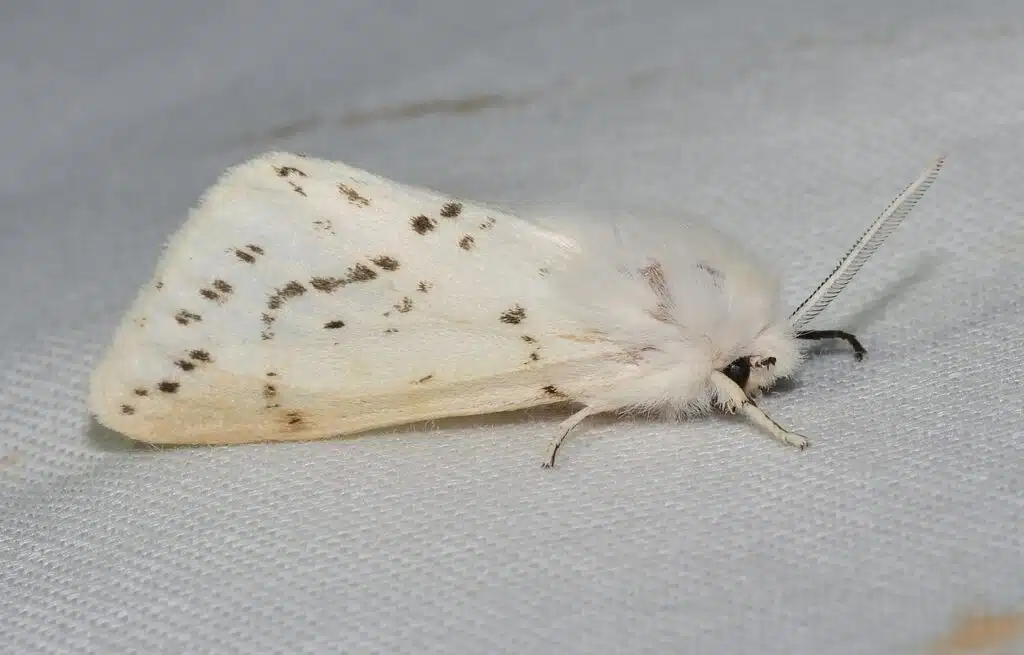
Fall Webworm Moths (Hyphantria cunea) are some of the most common native species in the US. This white moth has small differences from one area of the country to another when it comes to its looks.
Fall Webworm Moths are almost completely white in Northern US territories.
The species has brown spots across the forewings in the case of males for groups living in the South.
With a wingspan of up to 42mm, Fall Webworm moths also have a hairy upper body and are mostly seen on trees.
These white moths are major tree pests with limited to no impact on healthy trees. They specifically choose old trees or sick trees as hosts.
You can see this white species around woodlands. Hardwood trees are among their preferred hosts.
2. Salt Marsh Moth
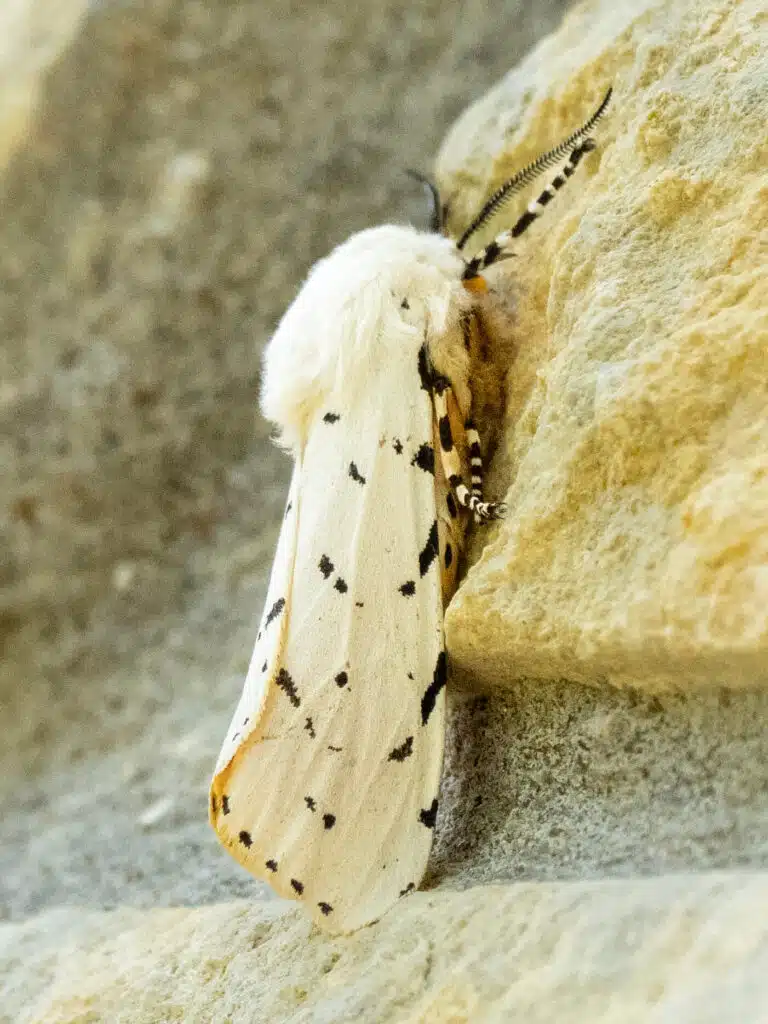
Salt Marsh Moths (Estigmene acrea) are a native white species that are also larger than others. This moth has a minimum wingspan of 4.5 inches as an adult but some of the largest moths of the specie reach a wingspan of 6.8 inches.
Salt Marsh Moths are only partially white. The species has white forewings with black spots, similar to the forewings of the male Southern Fall Webworm Moth.
The hindwings of the species are orange with a few black dots. The body of the moth is also white and orange with black dots.
The number of black spots on the hindwings always varies between 3 and 4 both in male and female moths.
3. Virginian Tiger Moth
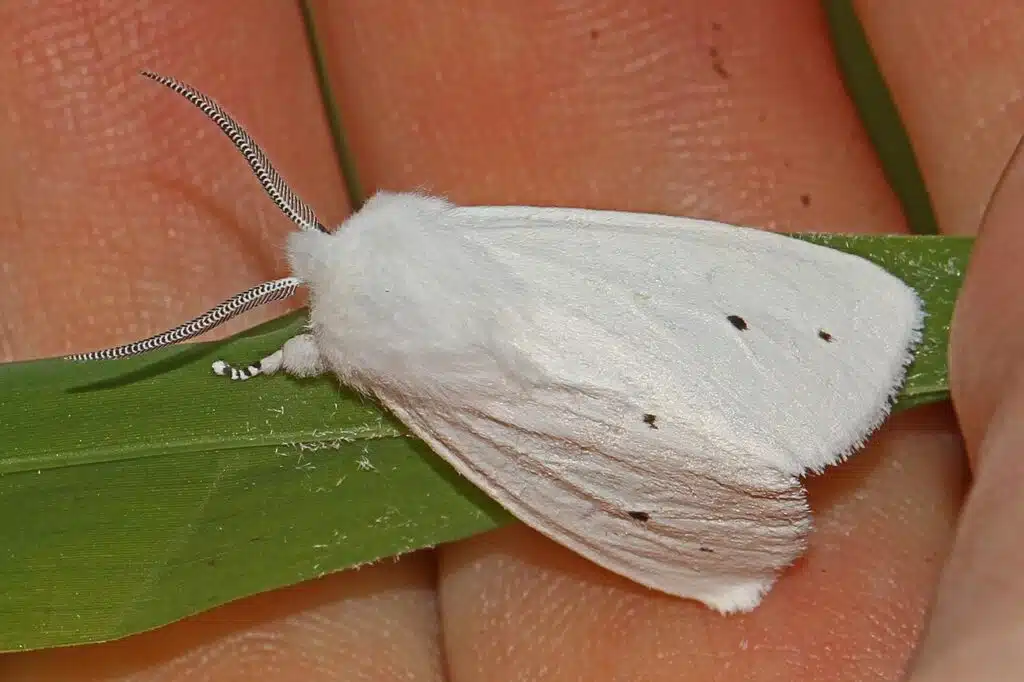
Virginian Tiger Moths (Spilosoma virginica) are a common species of almost completely white moths. The species has a pure white color across the forewings and hindwings.
This species has a pure white body with 6 black dots across the central part of its body.
Short white hairs are visible on its upper body.
The Virginian Tiger Moth is one of the most complex species in terms of its pest status. Its caterpillars feed on clovers and grasses but they only cause significant damage towards the end of the season.
It’s with a high number of caterpillars that the Virginian Tiger Moth has a pest status. It’s not seen as a major pest in the spring or early summer.
The caterpillar of the species doesn’t have the same white color. Virginian Tiger Moth caterpillars have a yellow color.
4. Lesser Maple Spanworm Moth
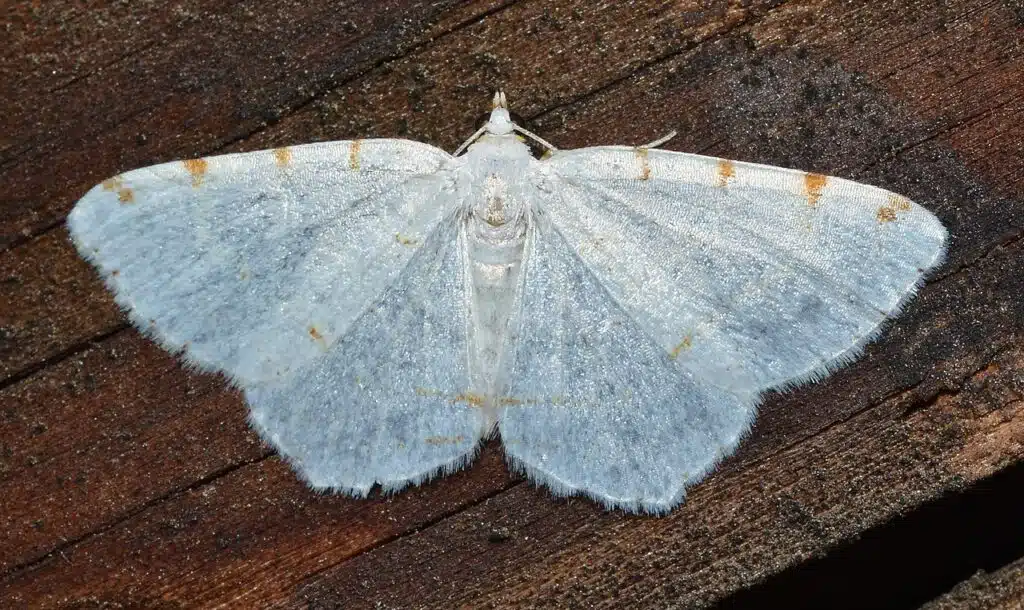
Lesser Maple Spanworm Moths (Macaria pustularia) are a native white species closely tied to maple trees.
This is a common species across maple trees in most US states but the caterpillars of the species are also increasingly reported on other hardwood trees.
Lesser Maple Spanworm Moths feed on the leaves of various maple trees to the point of complete defoliation.
You can identify this moth by its white color. Its forewings and its wings are almost completely white. A pure white is specific to this species.
Small orange marks on top of its forewings are seen in the species. There isn’t a fixed number of marks across its forewings as with other moths that live on maples.
Its hindwings show faint orange lines.
You can find the Lesser Maple Spanworm Moth on maple during different periods. It lives until August in the Northern States and a bit less in Southern states.
5. Large Lace-border Moth
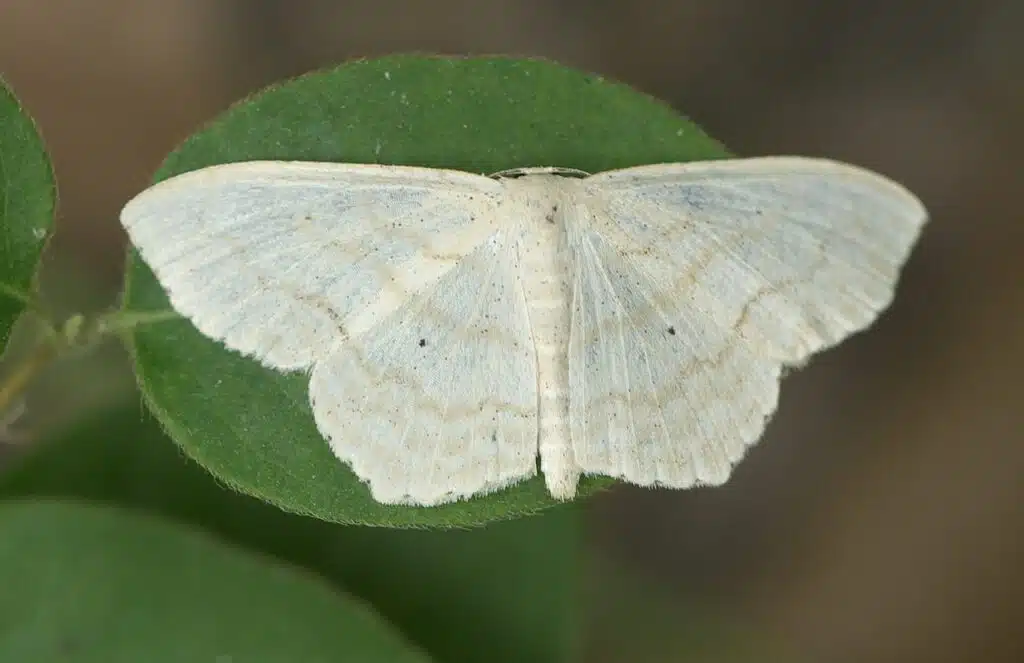
This large white moth (Scopula limboundata) is one of the oldest known moths in North America. It lives in most states in the Eastern parts of the US.
Large Lace-border moths have white forewings and white hindwings.
A faint gray border is seen across its hindwings. This species has a white body with long white antennae.
Large Lace-border Moths are seen frequently as they have a diverse diet and many host plants.
They can be seen both on short vegetation as well as on trees. Blueberries are often a host species of Large Lace-border Moths.
Apple trees and black cherry trees are also among their preferred hosts.
The Large Lace-border Moth can occasionally use dandelions as an alternative host.
6. Snowy Urola Moth
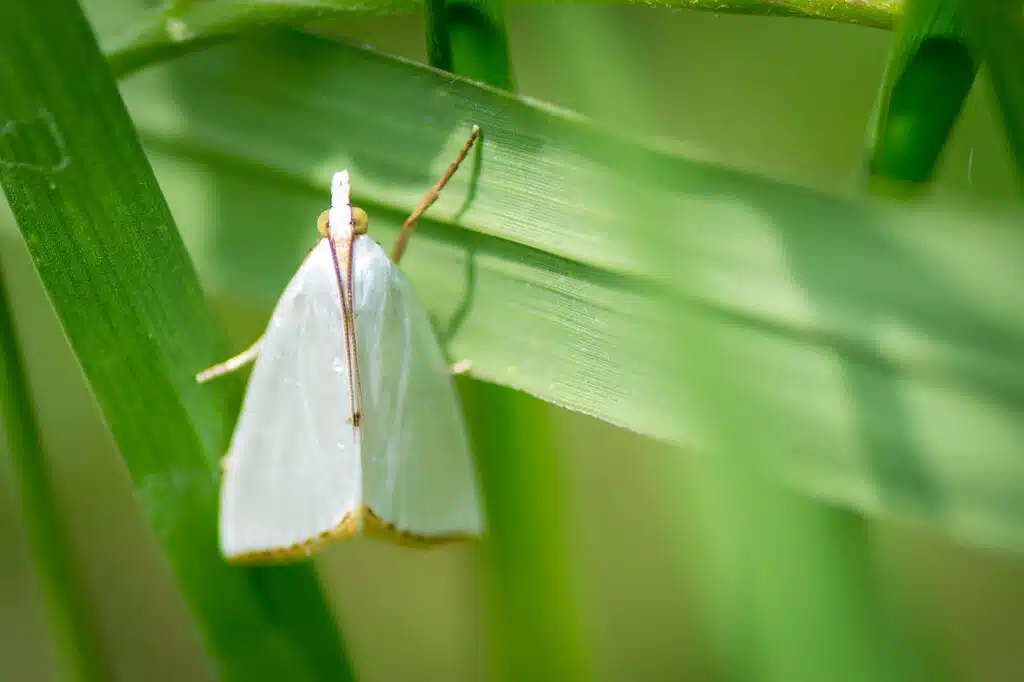
Snowy Urola Moths (Urola nivalis) are among the small native white moth species found in North America.
This species has a widespread presence in Southeastern habitats.
It has white forewings and white hindwings with yellow margins. Yellow bands along the lateral sides of its head are also visible.
The species has a short wingspan. Most moths of the species measure less than 20mm in wingspan with 23mm being the upper limit.
There are 2 broods seen every year up until September in Florida and Texas. Only one brood per year is characteristic of other states.
In Florida, the species is in the Southern parts of the state. Peninsular Florida is where this moth is seen in high numbers.
Moths of this species feed on short grasses such as privets.
7. Agreeable Tiger Moth
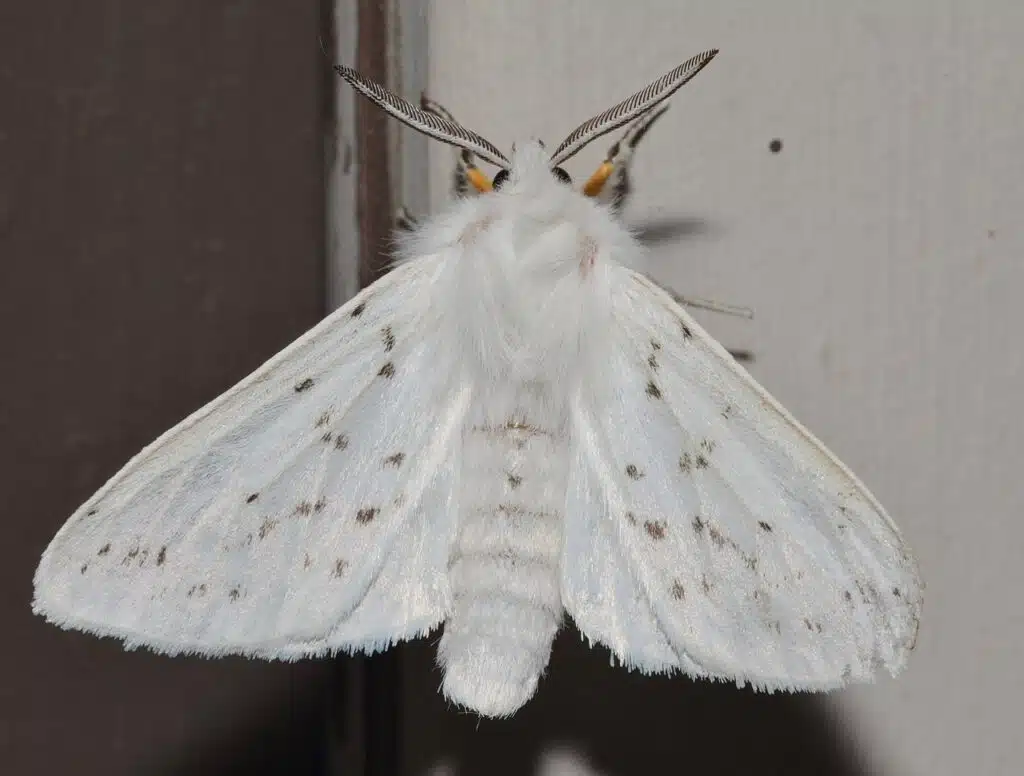
Agreeable Tiger Moths (Spilosoma congrua) are related to Virginia Tiger Moths. This is best seen in the appearance of these species.
While similar, these moths have sufficient distinctive physical traits to tell them apart.
One of the unique traits of the Agreeable Tiger Moth is its orange section below its head.
2 large black eyes contrast the white body and the white wings of the Agreeable Tiger Moth.
This species has white forewings and white hindwings with brown spots across.
Agreeable Tiger Moth caterpillars lack any type of white pigmentation. Caterpillars of the species have a base black color with orange bands across. Long black bristles are also specific to the species.
8. Delicate Cycnia Moth
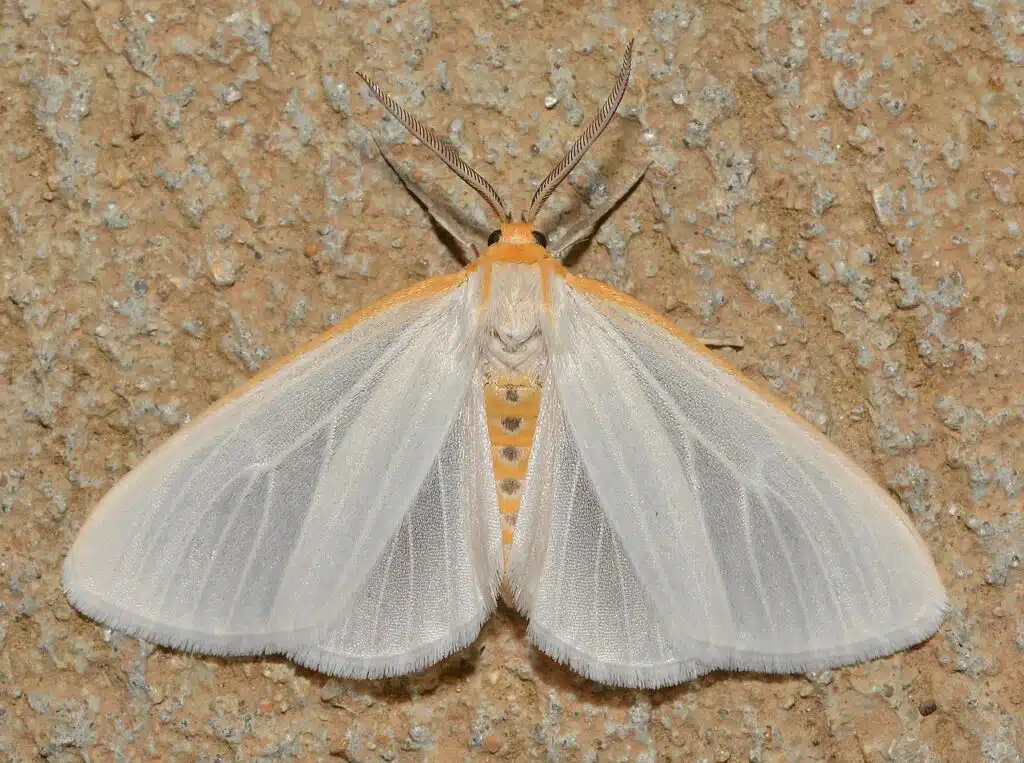
Delicate Cycnia Moths (Cycnia tenera) are some of the pure white moths specific to the South. This species is common in Texas and neighboring states.
Pure white pigmentation is specific to its forewings, hindwings, and its body.
You can differentiate the species from other white moths by the long yellow band across the upper side of its forewings.
This species is further known for its small to medium size. Most Delicate Cycnia Moths never grow to a wingspan longer than 40mm.
Caterpillars of this genus are known to grow in small groups on plant leaves. Dogbane leaves are the preferred host and food of its caterpillars.
Some people identify Delciated Cycnia Moths as the Ultrasonic Moths. Adults of the species use ultrasonic sounds to keep predators such as bats away.
The ultrasonic sounds are also used by males to call females.
9. White Spring Moth
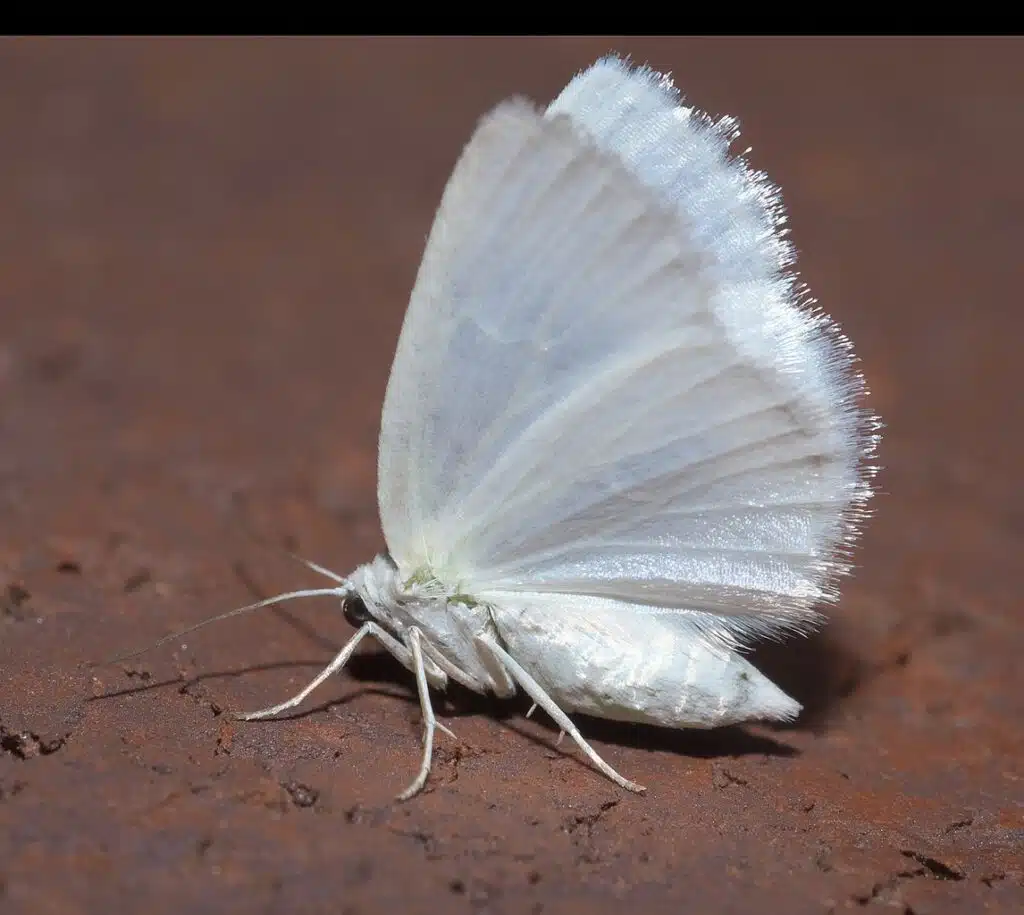
This small species of moth (Lomographa vestaliata) is known for its pure white coloring that almost looks transparent.
Its thin wings make for reduced white pigmentation in direct sunlight compared to other more visible species.
You can find White Spring Moths all across North America and through Western Canada.
The species has a short wingspan of around 20mm and a white body that resembles the same white nuance of the wings.
White Spring Moths are known to live in areas with plenty of vegetation.
The moth is not as common on fruit-bearing trees as other moths but it uses other trees and plants as hosts.
May trees and prunus are among the favorite species of the moth.
10. Plain Plume Moth
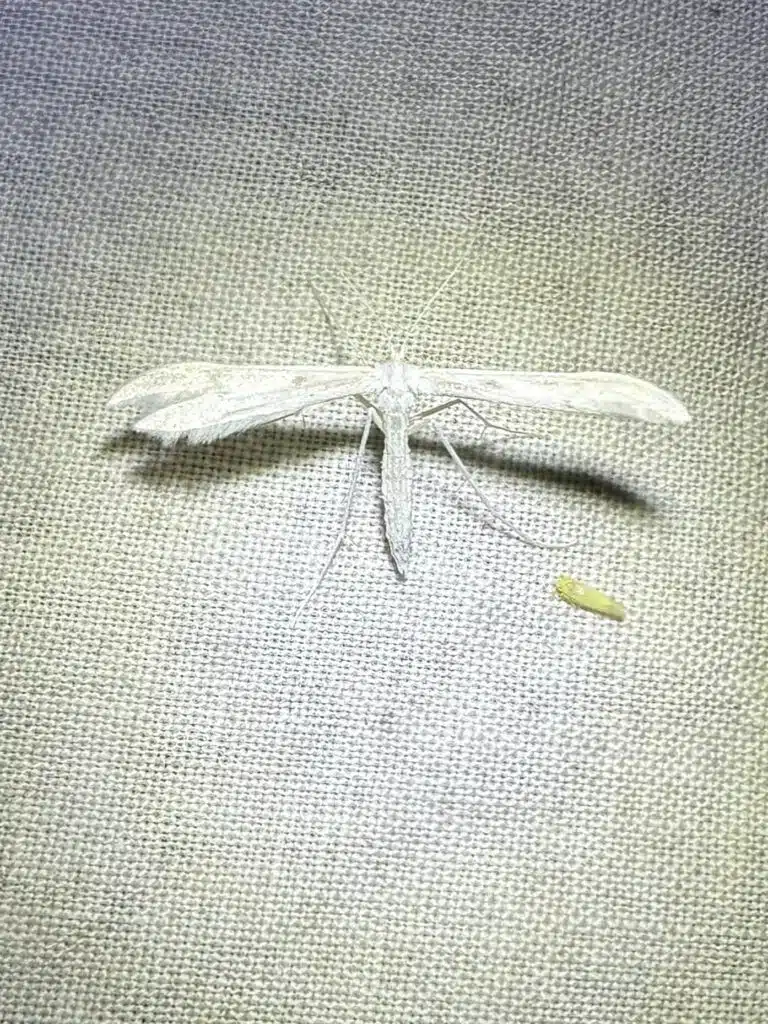
Plain Plume Moths (Hellinsia homodactylus) are found in some of the most populous areas of the United States.
You can find this moth both in New York and in California as well as in many other urban areas.
The species is identified by its white wings and white body. Its forewings have a translucent nature to them which means they have lesser white pigmentation compared to the hindwings and to the body.
Tiny brown spots are often seen across the forewings and even across the body.
Moths of this species have a small dimension as they only grow to a maximum of 27mm in the wingspan.
The species is known for having carnivore caterpillars. The caterpillars of Plain Plume moths often feed on parasitic cabbage bugs.
11. Little White Lichen Moth
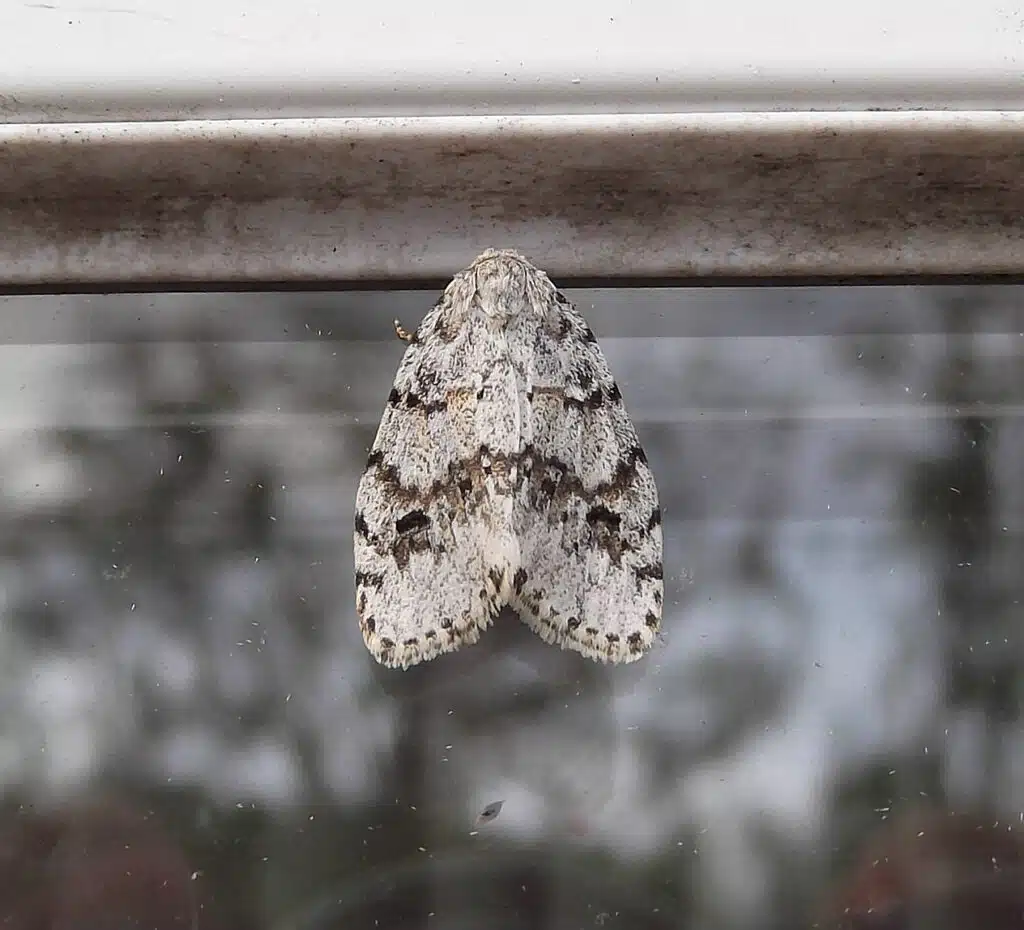
Little White Lichen Moths (Clemensia albata) are one of the white species native to California.
This type of moth isn’t completely white as it has gray to green patterns across its wings.
The forewings are white with patterned gray-green areas.
White is the dominant color of the hindwings.
As its name implies, this moth feeds on lichen that grows on trees. Some of the colored patterns across its wings can be an evolutionary trait in which the moth resembles lichen.
Little White Lichen Moths are also some of the smallest native white moths founds in North America.
The species has a maximum wingspan between 10 and 11mm.
You can find this moth species in Southern US habitats, especially in the summer.
It has a flight season that expands from June to early fall.
12. Olive-shaded Bird-dropping Moth
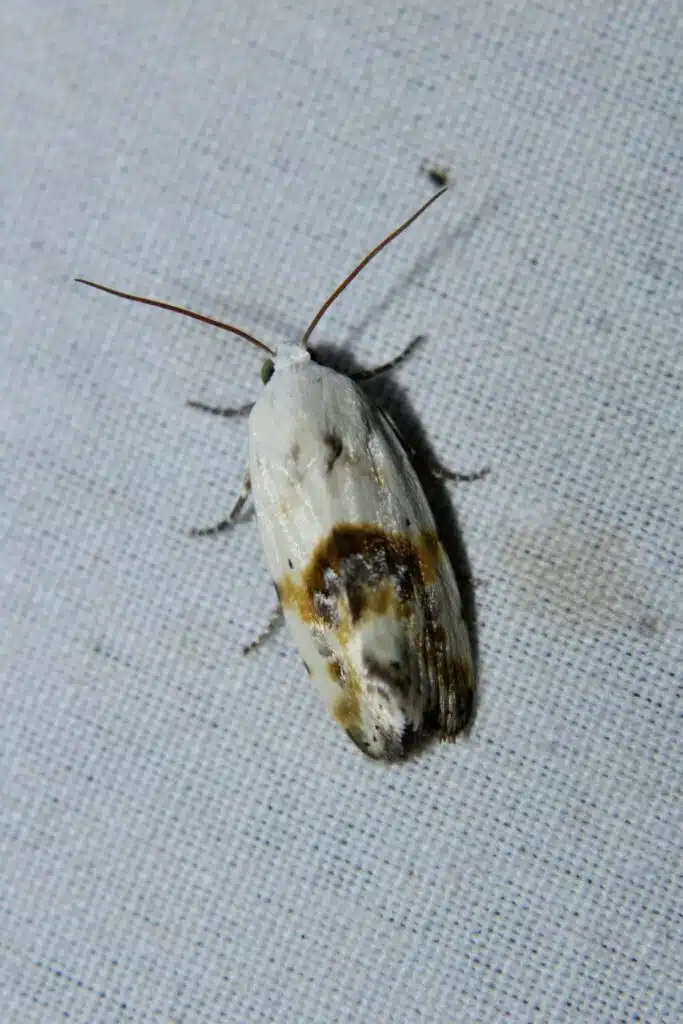
This white type of moth (Ponometia candefacta) is also known for showing olive, gray, or brown spots across its wings.
White is still the base color of the species but its wings also show a colored pattern that makes the species unique.
This species is believed to mimic bird droppings. The appearance of bird droppings is embraced when the moth rests with its wings close to the body.
Bird-dropping mimicry is believed to be used defensively against birds and bats.
You can find the Olive-shaded Bird-dropping moth across various dry terrains such as fields.
The flight season of this white moth is one of the longest in the country. The moth is active from early April and it flies until September.
Like many other white moths, this species uses different aster species as host plants.
13. Dot-lined White
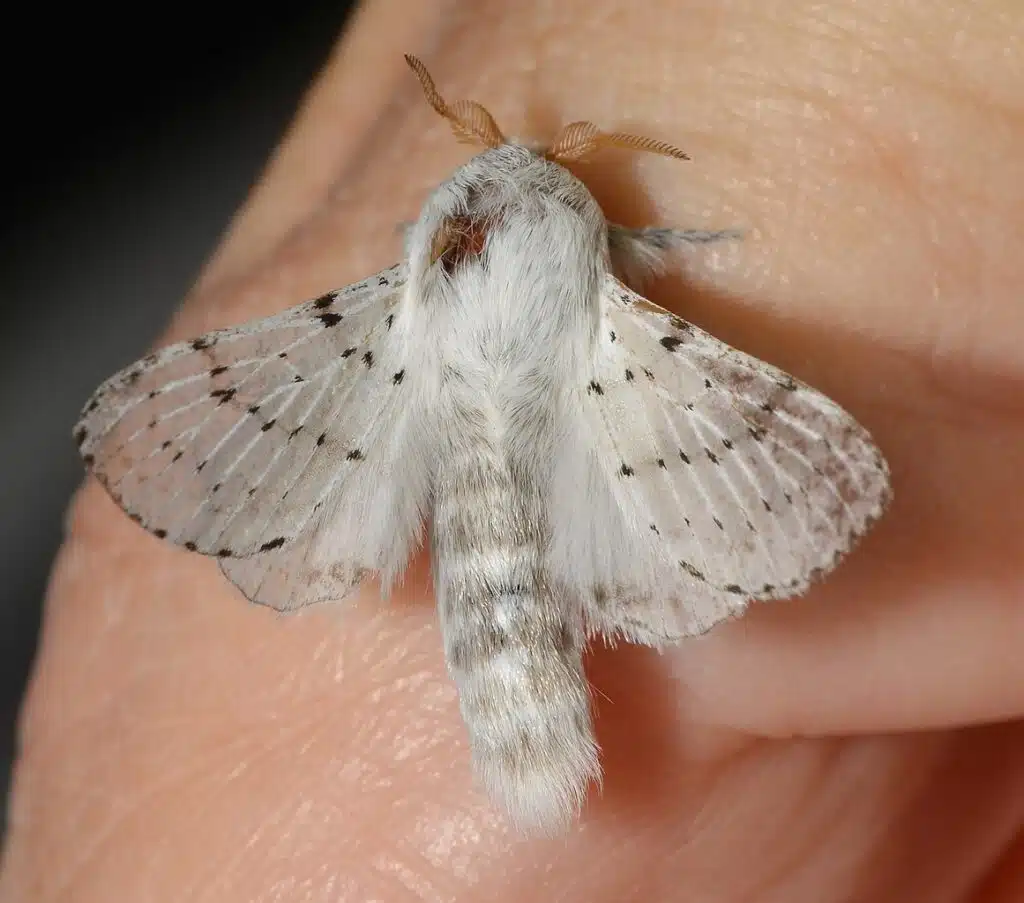
The Dot-lined White Moth (Artace cribrarius) is a species with a white base color and small black sections.
Tiny black dots connected by white lines are seen across its wings. White borders are also specific to its wings.
Dot-lined White Moths have mostly white bodies covered in short white hairs.
Its antennae are a combination of white and black alternating bands.
Seeing a Dot-lined White Moth is not met with joy by those who grow cherries as these are pests of cherries by eating leaves to skeletonization.
This species is most commonly found in oak woodlands where they are also known to be a pest of oak trees.
In urban areas, Dot-lined White Moths are a known rose pest.
14. White Slant-Line
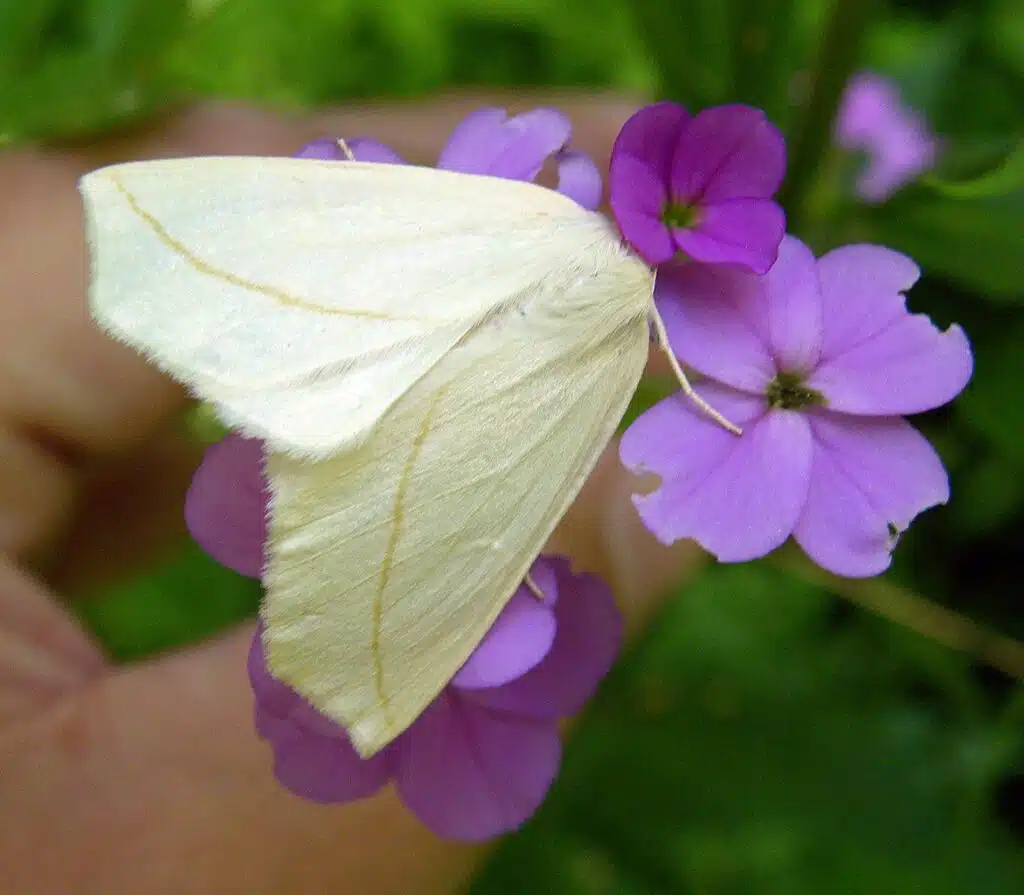
White Slant-Line Moths (Tetracis cachexiata) are a native species with a widespread distribution.
This moth species have multiple host trees and it’s seen as a pest on most of them.
Found both in dry and humid areas, the White Slant-Line moth is seen on species such as walnuts, ash, birch, cherries, and willows.
Its presence next to a water source is solely signaled on willows. The species is found both on hardwood trees and on fruit-bearing trees.
White Slant-Line Moths are among the multiple small white species native to the US. These moths have a maximum wingspan of up to 26mm.
The species is found in all tropical and temperate climates of North America.
Its lifespan is short as the moth only lives from May to June.
15. Small Bird-dropping Moth
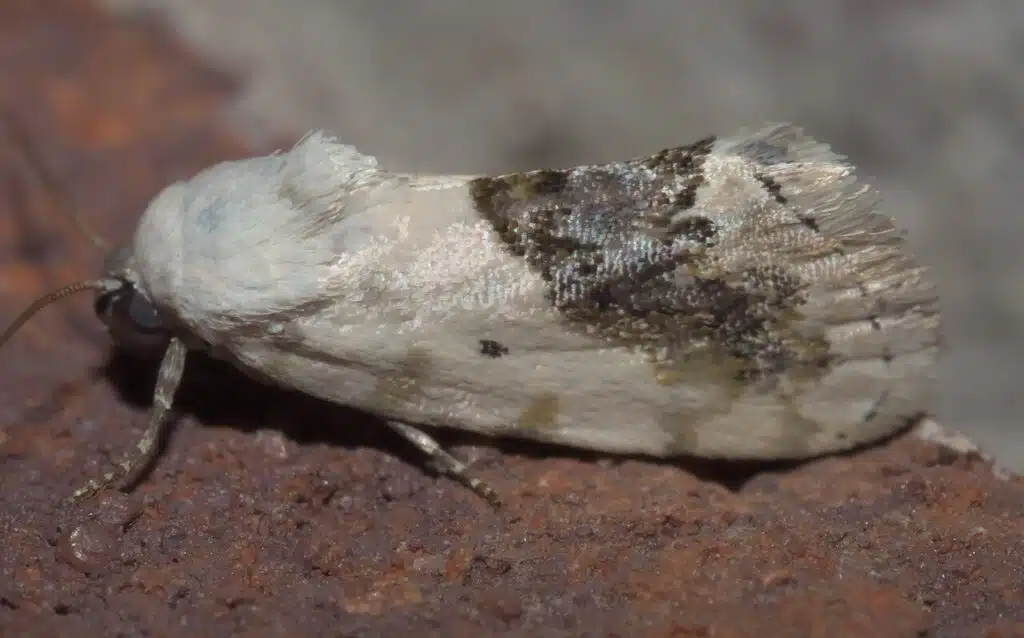
Small Bird-dropping Moth (Ponometia erastrioides) are a mostly white species native to North America.
This moth mimics bird droppings with the aim of making its predators move along thinking it has bad taste.
White base coloring is met with yellow, gray, and brown patterns.
This species has an off-white base color instead of a pure white color like other mostly white small moths in the US.
With a wingspan that stretches to a maximum length between 16 and 22mm, the Small Bird-dropping Moth is also known to have a reduced size.
This species is seen in dry areas and fields next to lakes and rivers.
Ambrosia flowers tend to be the main host plant of the species.
16. Large Tolype Moth
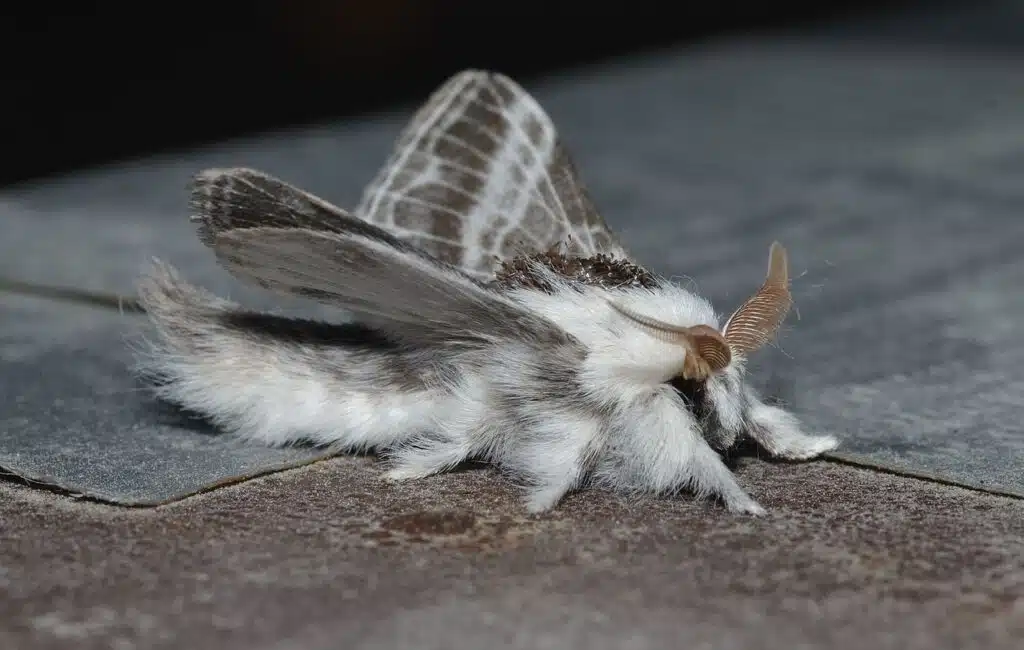
Large Tolype Moths (Tolype velleda) are a medium to large North American white moth species. Its wingspan often measures up to 58mm.
This moth is known for having a hairy body and a combination of white and gray colors.
Its hairy body is mostly white.
Its wings have a light gray and dark gray color combination. Its darker wings show white veins and white margins.
Gray is the dominant color of the wings.
Large Tolype Moths are seen across cultivars and on various trees. Most commonly, the white moth is seen as a pest of apricots and apples.
To a lesser extent, this moth is also seen as an oak tree pest.
Poplar, birch, and cherries are among the least common host species of the Larger Tolype Moth.
17. Gold-striped Grass-Veneer
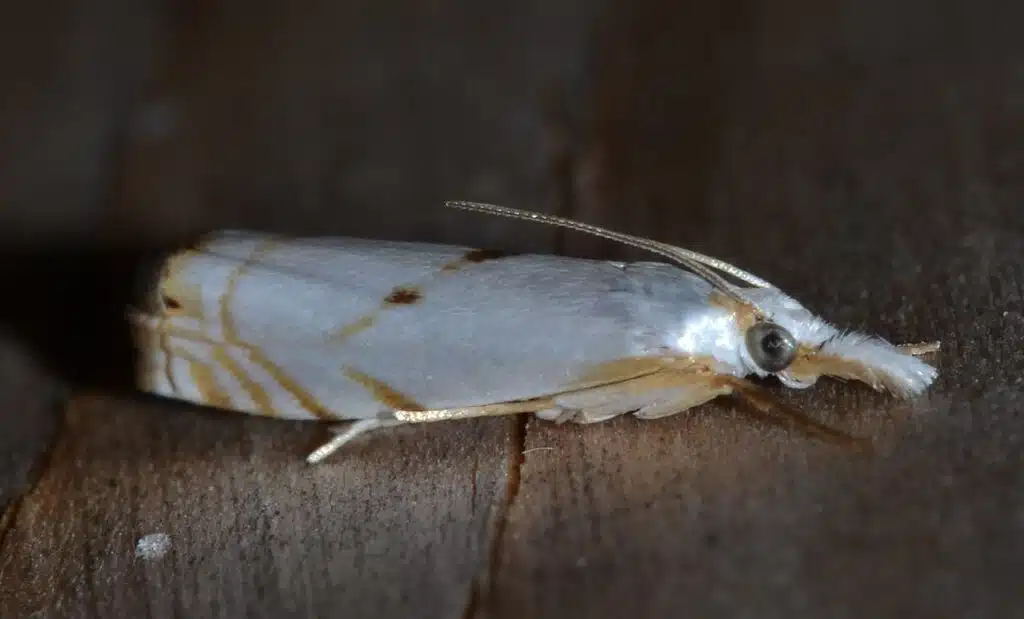
Gold-striped Grass-Veneer Moths (Microcrambus biguttellus) get their name from their feeding habits. They exclusively feed on grasses.
You can find these types of moths across the US and in certain areas of Central America.
Gold-striped Grass-Veneer moths are some of the smallest in the US. They have a wingspan of up to 8mm but are highly visible based on their glossy white wings.
Both the forewings and the hindwings are purely white.
Golden stripes and borders are seen across the wings of the species. Its head also has golden lines on the sides of the gray and black large eyes.
The antennae of the Golden-striped Grass-Veneer have a golden color while its legs are white.
18. Four-spotted Palpita Moth
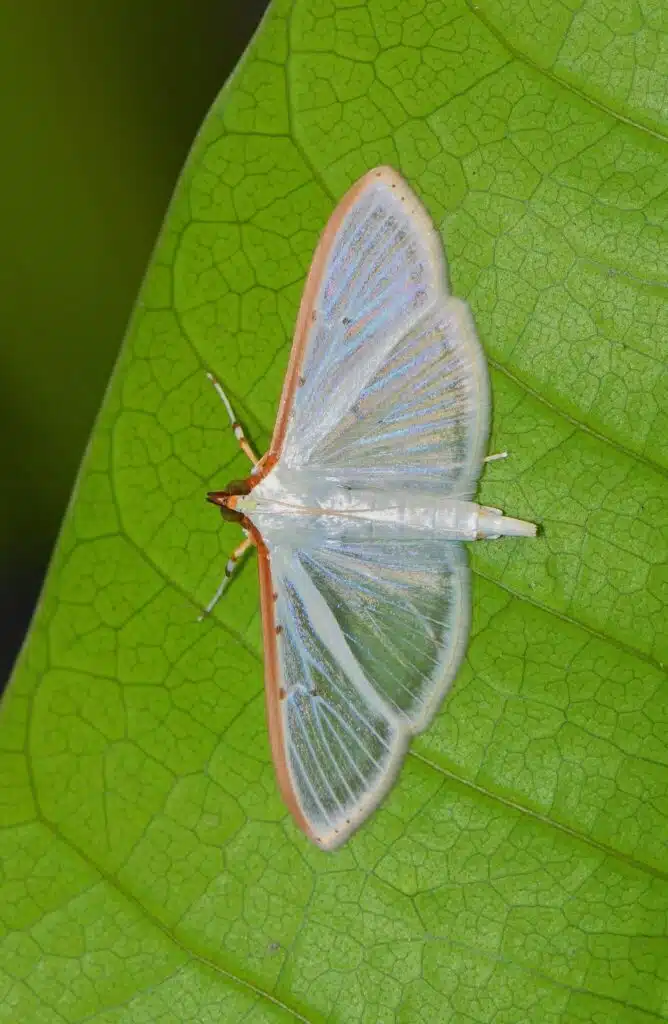
The Four-spotted Paplita Moth (Palpita quadristigmalis) is one of the most common white moths with transparent wings in the Southern US.
Mostly seen around Texas, this species has a white body with transparent wings that have golden-brown margins on the upper side of its forewings.
White veins and white margins are also specific to its transparent wings.
This species of moth might be a pest in certain habitats. It normally feeds and settles on grasses and short vegetation.
However, the past few years have seen the Four-spotted Palpita Moth attacking olives in Texas.
This moth is a pest of olives and one of the most common white moths to be seen in urban areas, particularly around gardens with olive trees.
19. Elm Spanworm Moth
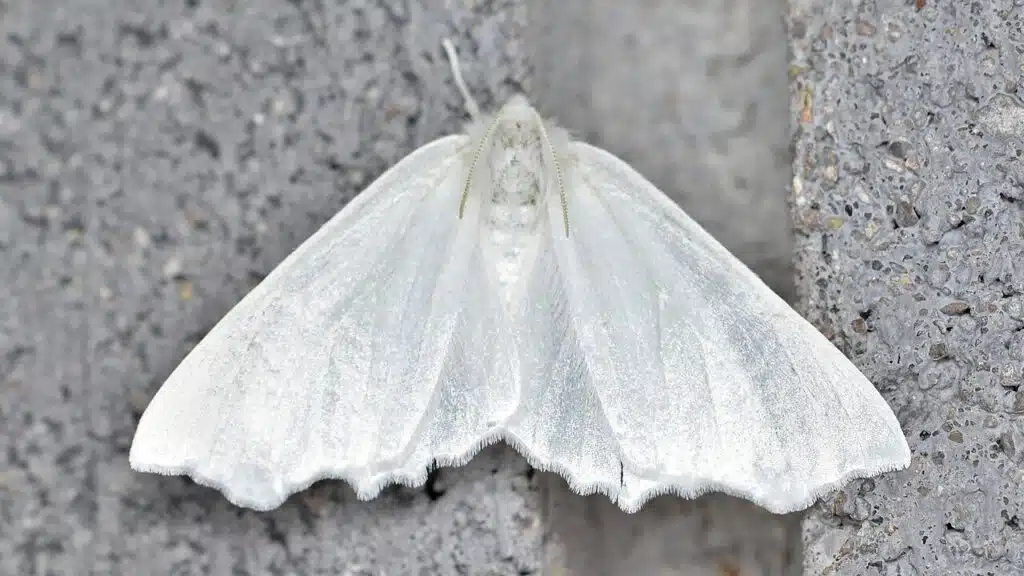
Elm Spanworm Moths (Ennomos subsignaria) are a native species of white moths across North America.
This species has a pure white color across its wings and on its body.
The white body of the species also has short white hairs behind the head. The legs and antennae of the species are also mostly white.
Common in states such as Alberta, the Elm Spanworm Moth is a considerable pest that needs to be eliminated with pesticides and other chemicals.
It defoliates a wide range of trees. Elm is the primary tree its caterpillars feed on.
Apple and birch are also trees that the white moth species can feed on. Considerable invasions can kill a tree within a few years.
20. Zebra Conchylodes Moth
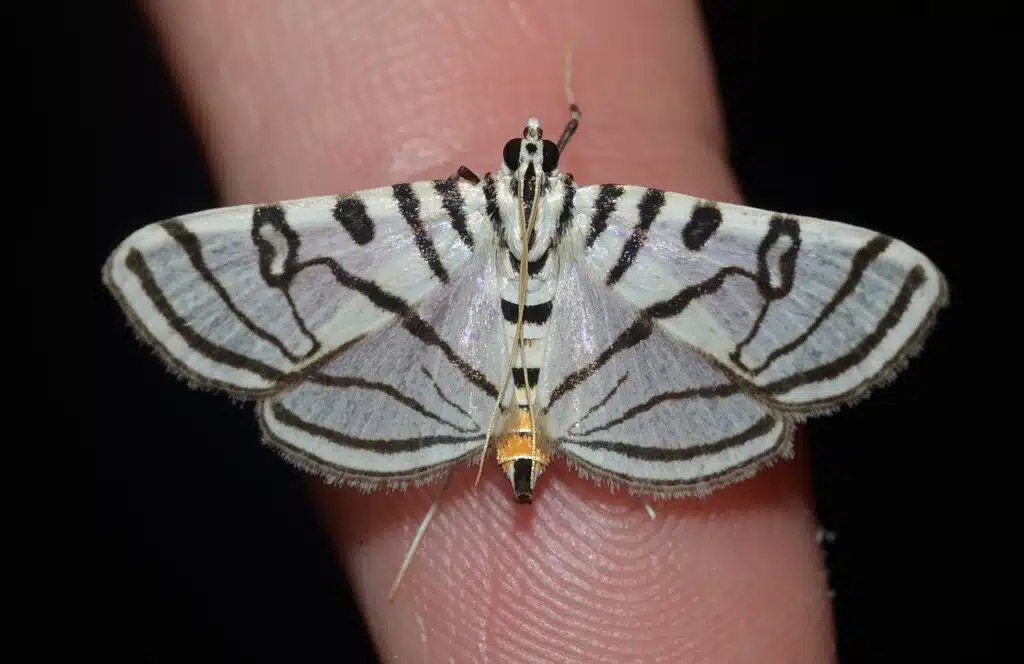
These types of moths (Conchylodes ovulalis) are named after zebras. They have a shiny white base color with black stripes across the head, wings, and body.
Moths of this genus are native to North America. They also live in Central and South America.
The black and white coloring of the species also names other zebra moths. You can differentiate this species from other white and black moths by the yellow to orange mark at the base of its hindwings.
These species also have white antennae with black spots.
Active until September, the species isn’t a major pest in gardens or woodlands.
It feeds on asters, but only as a caterpillar as the adult feeds on nectar.
This species has a small to medium size with a maximum wingspan of 30mm.
21. Milky Argyria Moth
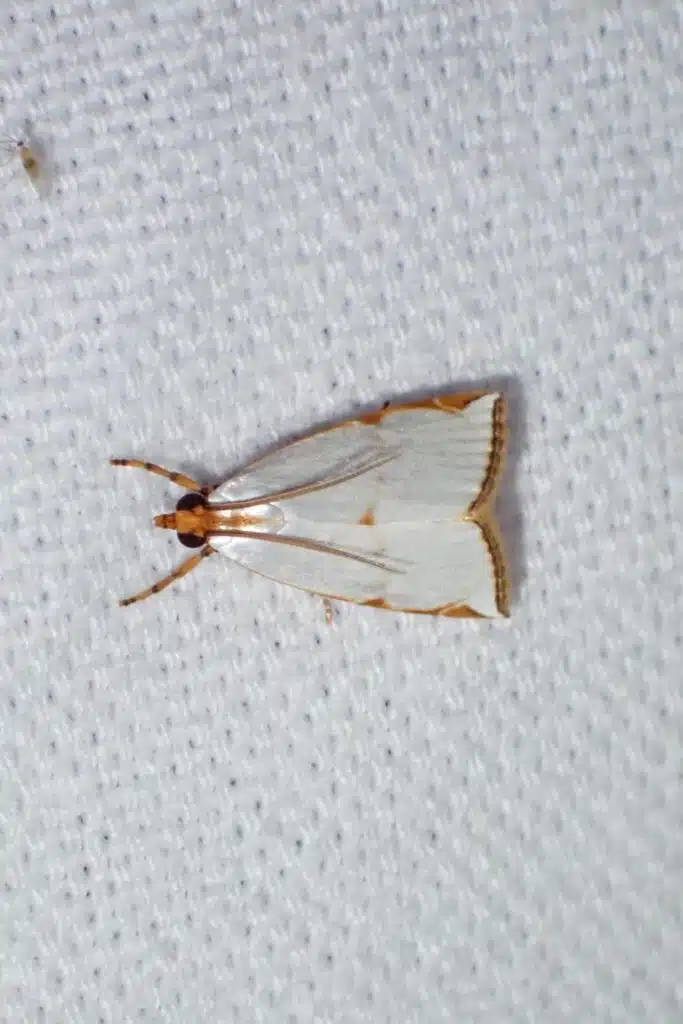
Milky Argyria Moths (Argyria lacteella) are native to states such as Maryland. They have a widespread presence in Eastern US states but they are also common in Southern states and Mexico.
To a lesser extent, these small white moth species are also found in South American tropical forests such as those in Brazil.
The species has a short wingspan and it mimics bird droppings. Most sections of its forewings and hindwings are white.
Pearl white is specific to this species as its wings become shiny in direct sunlight.
Brown and black marks, specifically on wing margins, make this species resemble bird droppings.
22. Speckled Lactura
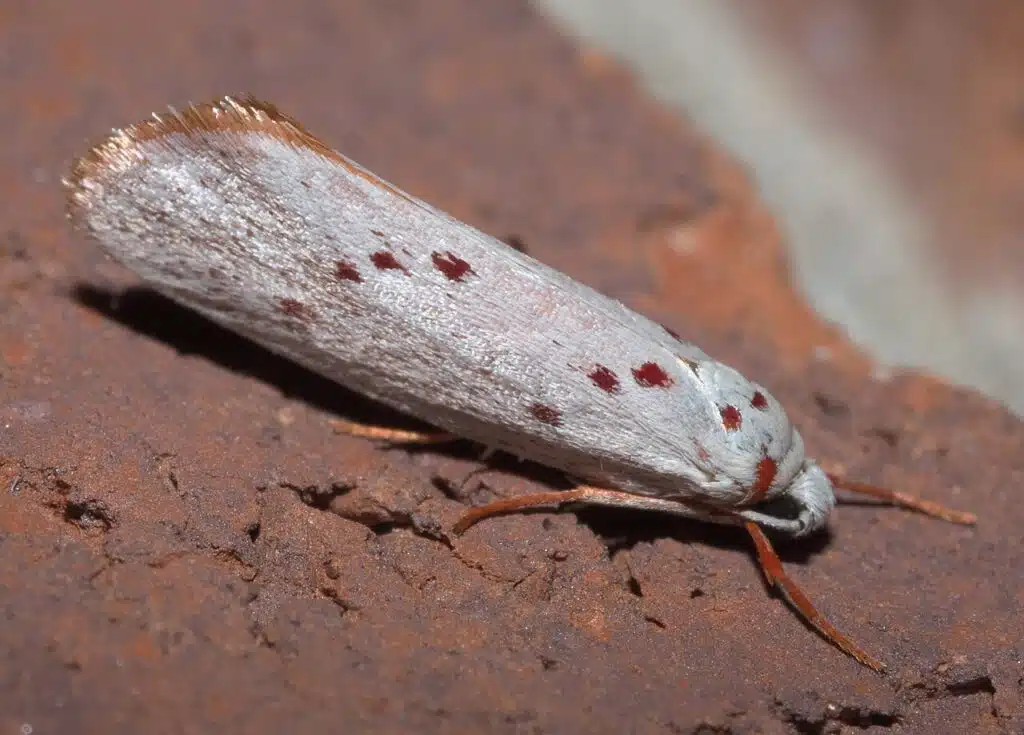
Speckled Lactura Moths (Lactura subfervens) are mostly white. The species has speckled forewings of a base white color.
Red spots are seen across its white wings. The red margins of the wings also offer contrast to its forewings.
The hindwings of the species are mostly red with pink to red hindwings in some groups.
Caterpillars of the species are only white in late instars as they begin life as green caterpillars.
They gradually become white caterpillars with black longitudinal stripes.
Tiny yellow dots are seen on the white section of the caterpillar, a trait inherited by adults with red dots on the white forewings.
23. Schlaeger’s Fruitworm Moth
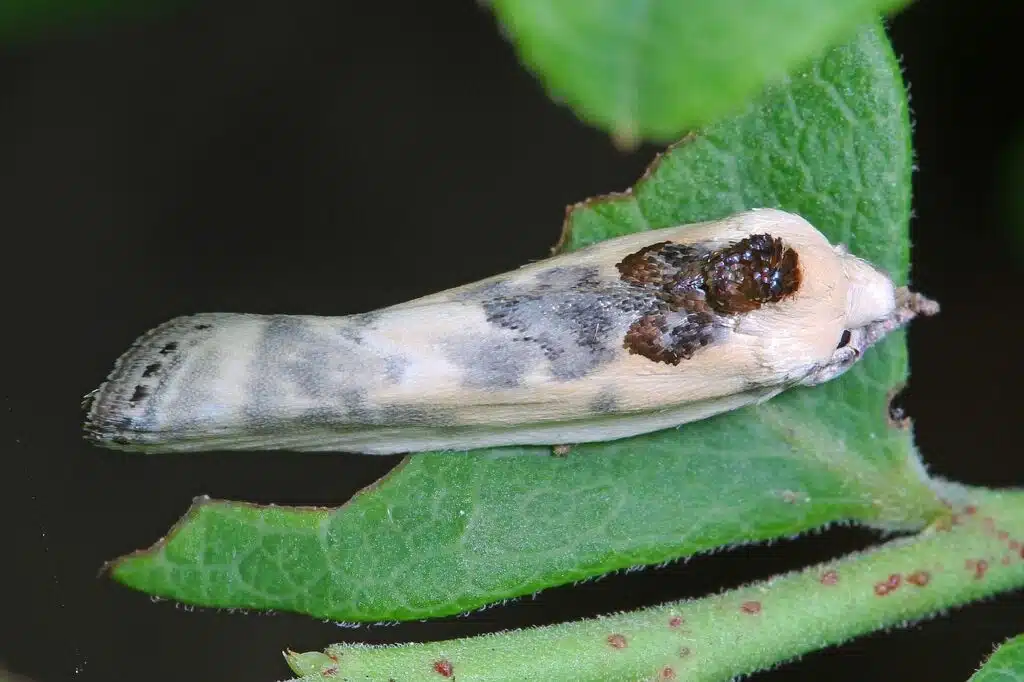
Common East of The Rocky Mountains, this species (Antaeotricha schlaegeri) has shiny white forewings with multiple dark spots.
These dark spots and the position of the wings when resting make the moth resemble bird droppings.
There’s a slight gradient on the marks across its white forewings. Darker spots are seen on the upper side of the forewings.
Light gray marks are seen on the lower side of its hindwings.
Moths of this genus are mostly seen in medium to high-elevation woodlands.
Oak tree leaves are among the most common nesting sites for its eggs. These leaves are used as food by emerging caterpillars.
24. White Stripe-Backed Moth
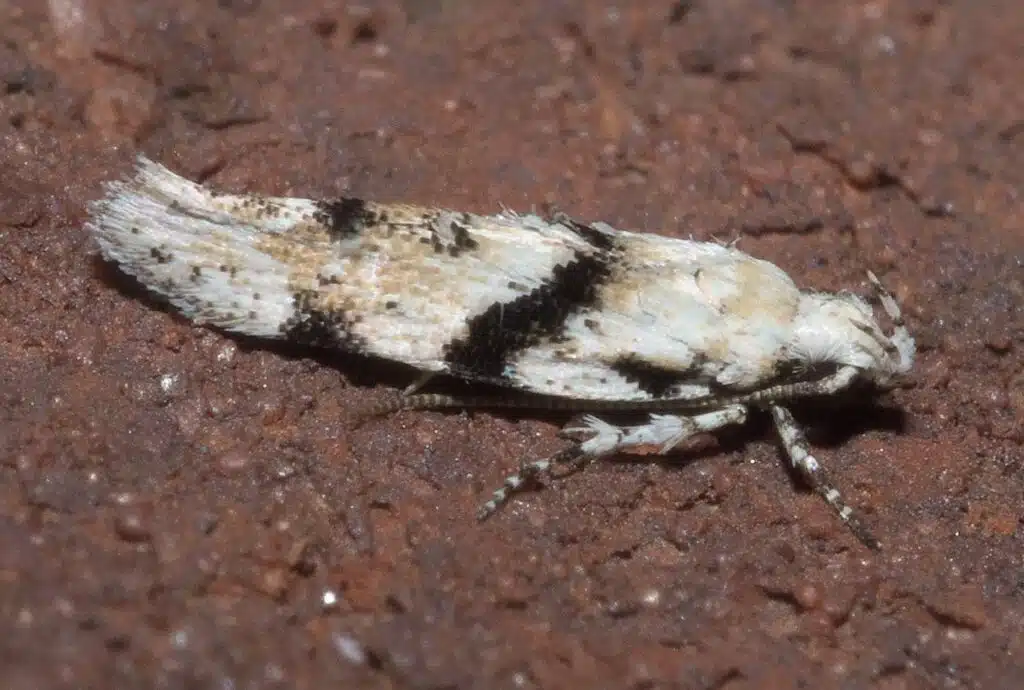
White Stripe-backed Moths (Arogalea cristifasciella) are some of the most common small white moths in North America.
This species has an average wingspan of 5mm. This makes it a tiny species with partially white wings.
Gray sections are also seen on its wings. A black band is further visible on the upper side of the forewings.
While small, this moth has a widespread presence in numerous states.
In general, it’s only active in the summer. However, its widespread North American distribution leads to a long average lifespan.
White Stripe-backed Moths have a flight season that starts in January and ends in August.
25. Spotted Peppergrass Moth
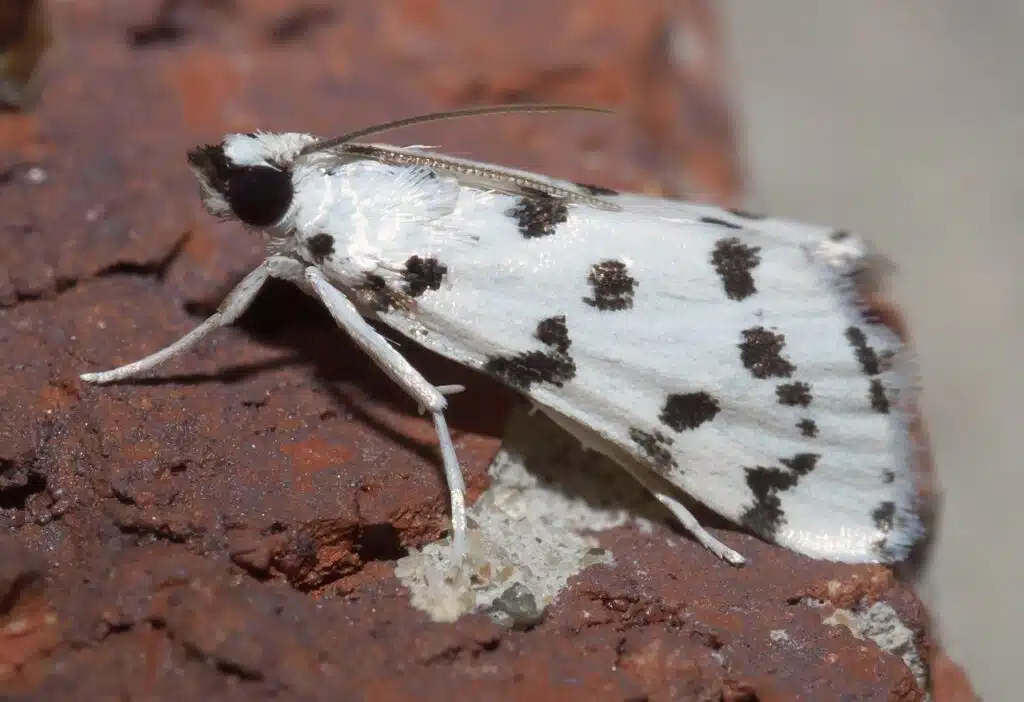
Spotted Peppergrass Moths (Eustixia pupula) get their name from the red-brown spot behind their head.
This species has a white-dominating body and wings’ pigmentation.
The size of the species recommends it as a small to medium white moth. Its wingspan measures a maximum of 17mm.
Its forewings show tiny black spots. Its legs and antennae are also completely white.
This species has a very specific flight season tied to the season of its host plants from June to August.
Mustards and cabbages are among their most common plants. This makes this small white moth a common sight on crops.
Chemical treatment is needed just before June to keep the species from being damaged.
26. Dot-lined Wave
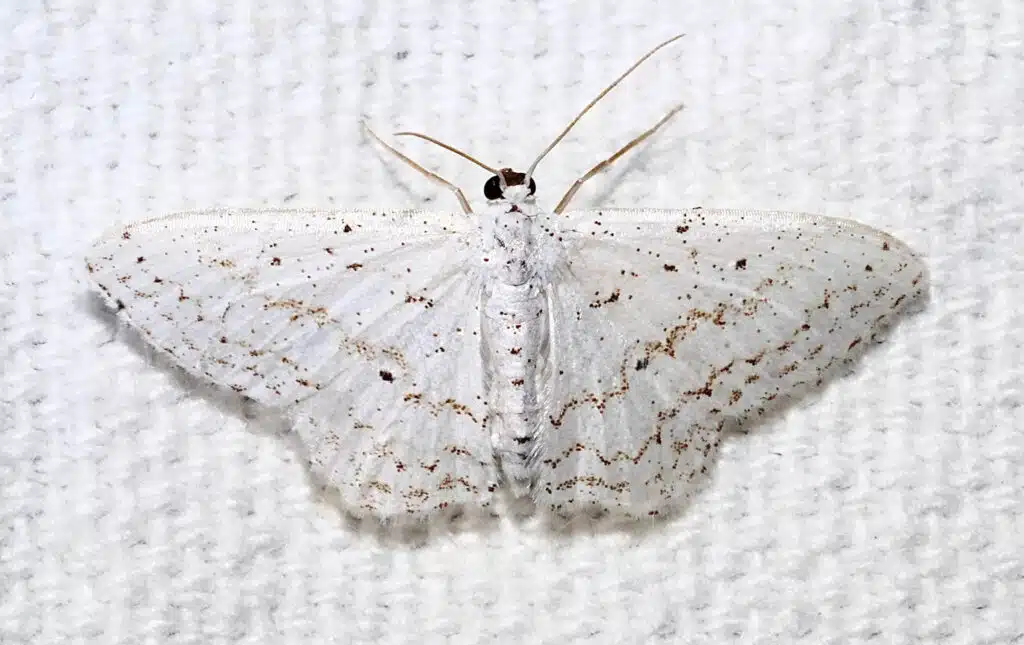
Dot-lined Wave Moths (Idaea tacturata) are some of the most common white moths with all-year flight.
Seen across Southern states, the Dot-lined Wave moth is known for being active throughout the year.
Virginia and Florida are the states where the Dot-lined Wave Moth is the most common in.
You can identify the species by its white forewings, white hindwings, and white body.
These moths also have cream to tan wave-shaped lines across the wings.
Most areas of the wings remain white. Pearl white is the specific nuance this species is known for.
Dot-lined Wave moths are also categorized as small moths. They have varying wingspan lengths which are never longer than 21mm.
27. Snowy Geometer Moth
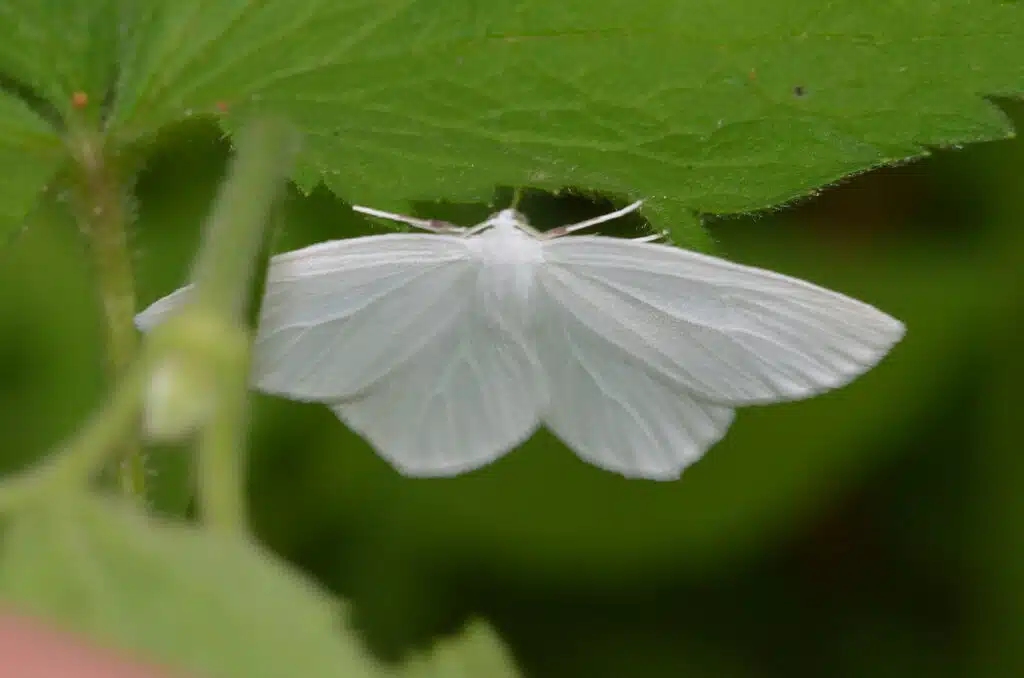
Snowy Geometer Moths (Eugonobapta nivosaria) are known for their pure white coloring. This species has white forewings, white hindwings, and a white body.
Pearl white is specific to all areas of the moth as there are no spots, marks, or stripes.
Snowy Geometer Moths are small species with varying wingspans. The length of its wingspan is never longer than 23mm.
Adult moths of the species lay small yellow eggs on the leaves of various host plants.
Mustards are among the favorite hosts of the Snowy Geometer Moth caterpillar.
Other fruit-bearing short plants are also a frequent host for the Snowy Geometer Moth.
Rubus flowering plants frequently attract these moths. These are small flowering plants related to wild roses.
28. Small White Grass-Veneer
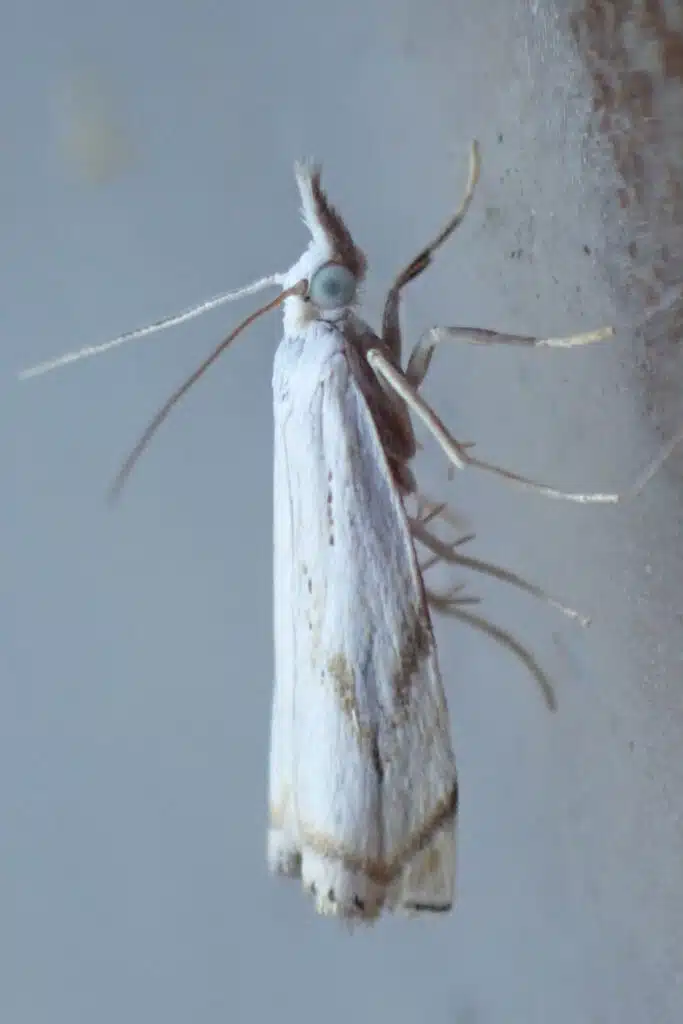
Small White Grass Veneer Moths (Crambus albellus) are a North American species with a high presence in Eastern states such as North Carolina.
This moth has mostly white forewings and a white body. There’s a darker mid-section line visible on the species together with golden yellow thin margins.
Metallic white is specific to the forewings of the species which tend to shine in direct sunlight.
Moths of this family have a reduced size and they aren’t known for fast flight.
Small White Grass-Veneers have a wingspan that reaches a maximum length of 16mm.
As the name of the moth implies, grasses are the main food source of the species, together with small shrubs.
You can see the Small White Grass-Veneer in areas of dense vegetation throughout the summer.
29. Melonworm Moth
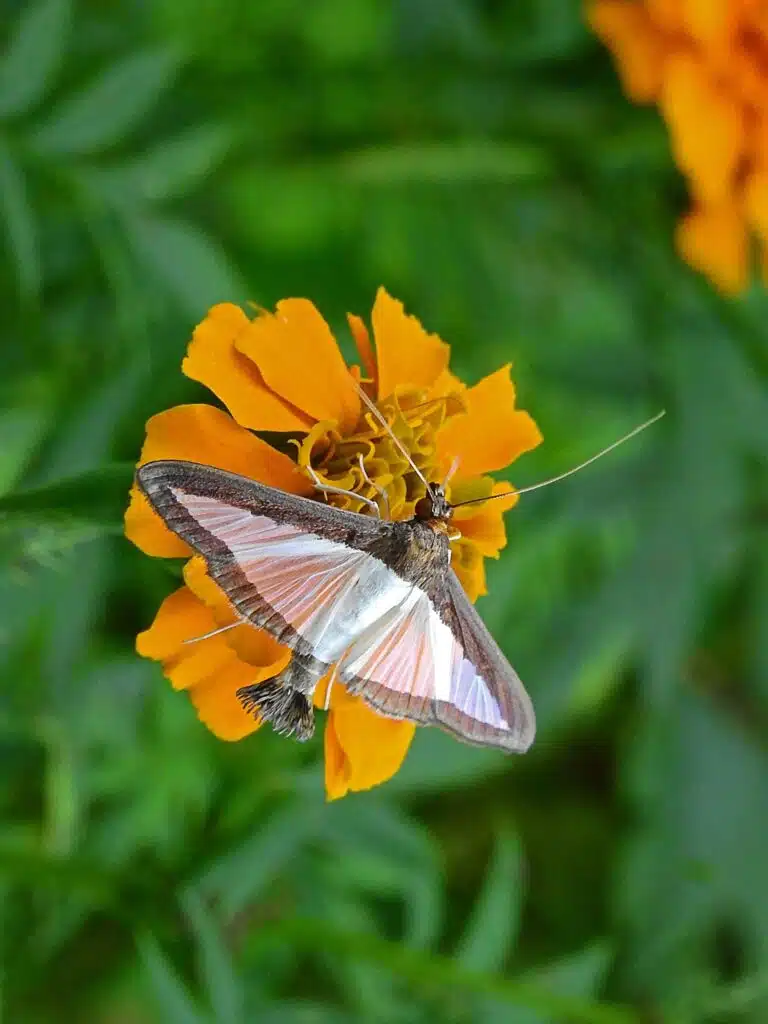
Melonworm Moths (Diaphania hyalinata) have contrasting colors across the wings. White dominates the wings while wide black margins are seen across its hindwings and forewings.
This species has a white body with brown and black hairs on the lower part of the body.
Brown hair also covers its head.
This moth has an iridescent white color which makes it stand out even more.
Melonworm Moths have a nocturnal nature and are rarely seen as a result.
This species is found on a wide range of cucurbits. Pumpkins are among its preferred hosts.
The moth attacks both wild and cultivated plants in the cucurbit family and it can quickly become a large pest problem on crops.
30. White Flannel Moth
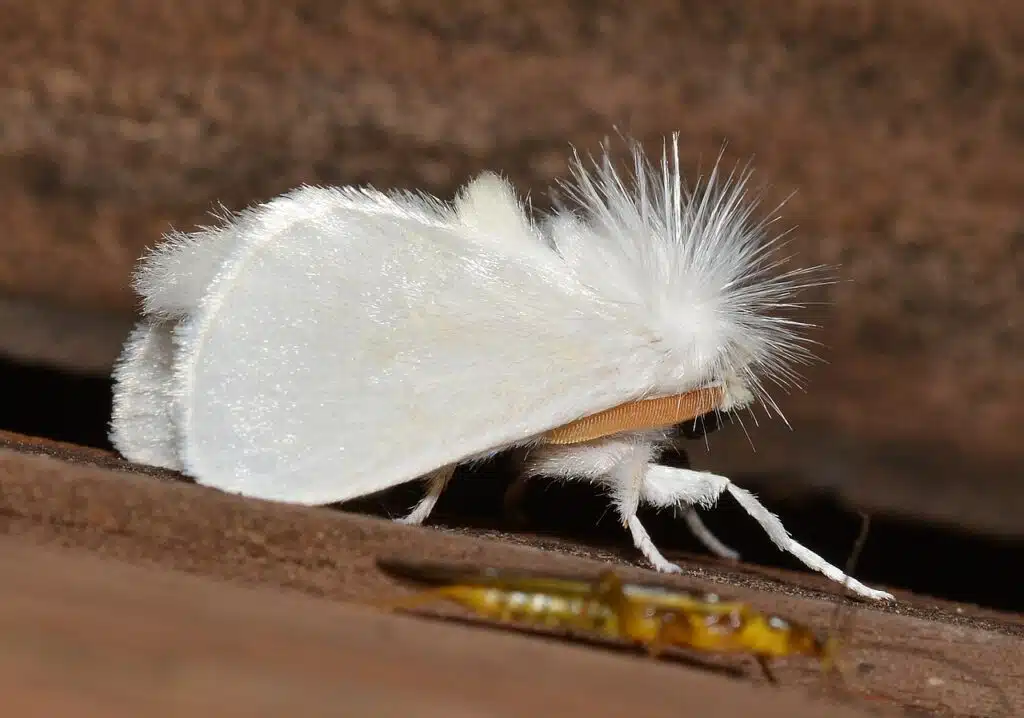
White Flannel Moths (Norape cretata) are native to Eastern US and Central America regions. This species is seen in woodlands, parks, and gardens.
An innate attraction to hardwood trees makes the White Flannel Moth most common in woodlands.
This species is seen on hackberry and black locust the most.
You can easily spot the moth on these trees as it has pure white coloring.
The wings, body, antennae, and legs are all white. There are no spots or marks across the species which means this moth is among the few white species that can be seen on tree bark easily.
Small differences between the species and other white moths can be seen on the upper body of the head which has long white hairs.
The size of these moths is small to medium with a maximum expected wingspan of up to 33mm.
31. Arge Moth
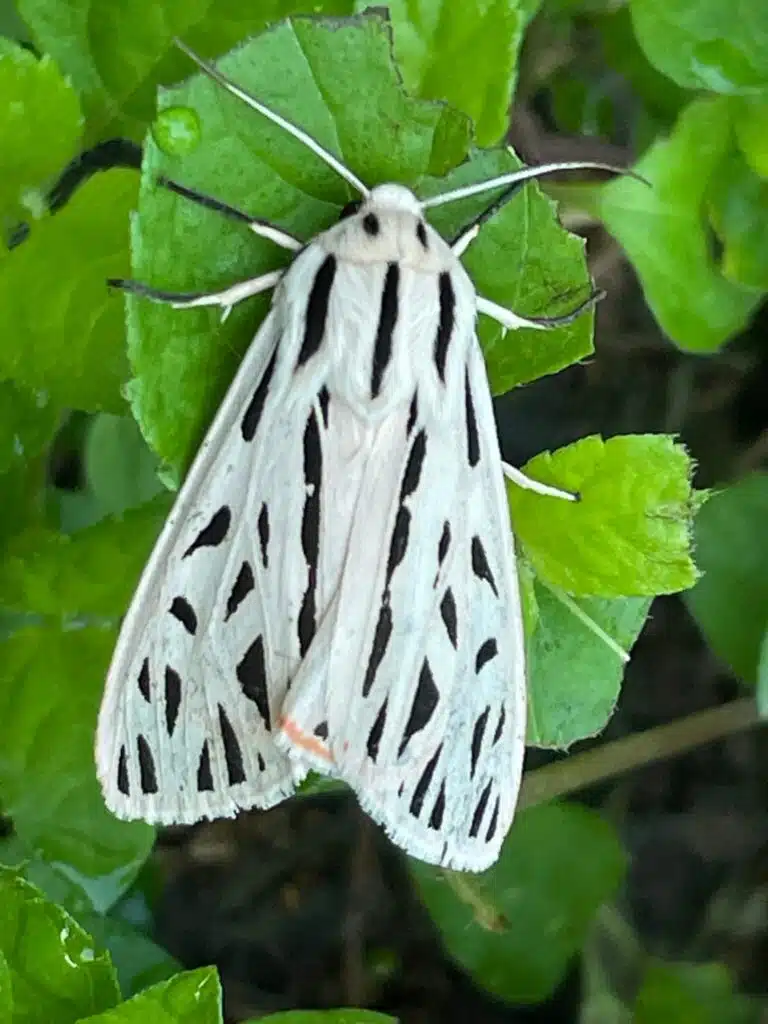
Arge Moths or Arge Tiger Moths (Apantesis arge) are white native species with black stripes. Its forewings show vertical and horizontal black stripes.
The species starts life as a black caterpillar with white stripes to become an adult white moth with black marks.
Arge Moths have a small to medium size as they can reach a wingspan of up to 50mm.
Seeing these moths either on crops or in the garden is a bad sign as they can eat various types of plants and vegetables as pests.
Corn, grape, and plantain are just a few of its favorite hosts this species can eat the leaves or fruits of.
On a commercial scale, Arge Moths are some of the most detrimental species to sunflower crops as the moth isn’t interested in wild sunflowers but in cultivated sunflowers.
32. Speckled Wave
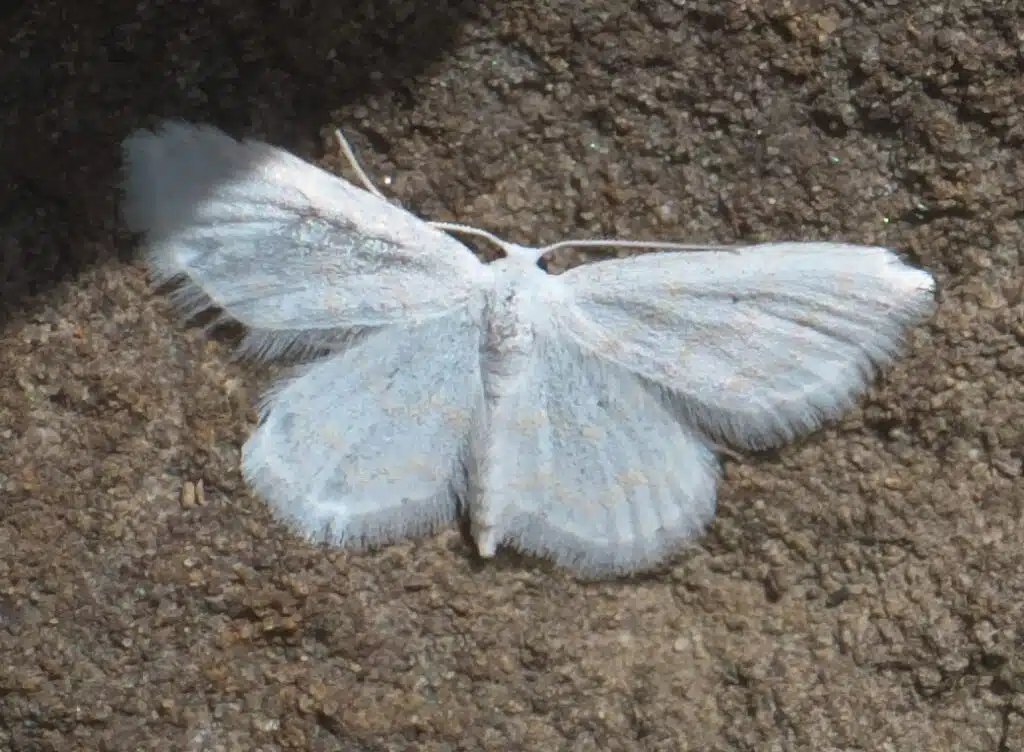
Speckled Wave Moths (Lobocleta peralbata) get their name from the patterned wave-shaped cream marks across their wings.
These moths have a base white color across the forewings and the hindwings. The body also has a white color.
Speckled Wave moths have a short wingspan of up to 20mm.
You can find these moths in various states but especially in Texas and Florida where the weather allows the species to be active from December to early fall.
33. White Underwing
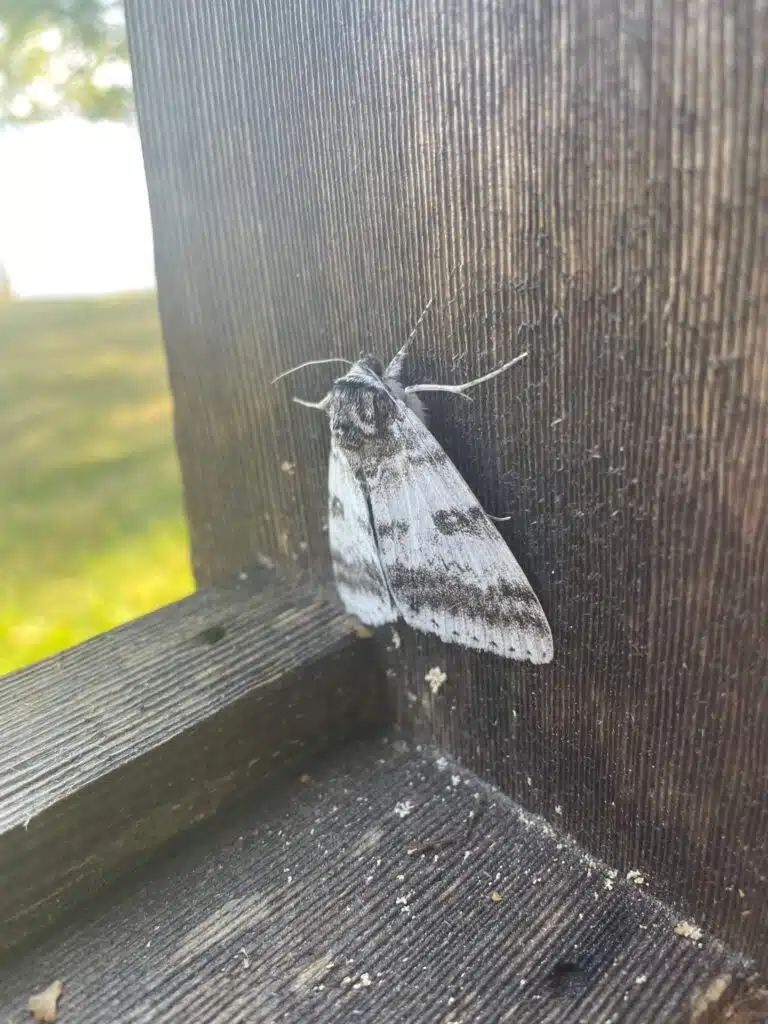
Northeastern US territories are the home of the White Underwing (Catocala relicta).
This colorful moth is found in many trees including poplar and willows.
The species has a base white color with gray to black overlays.
Its camouflage coloring differs from the forewings to the hindwings. The forewings are white with black patterns while the hindwings are black with white bands.
34. Orange-shouldered Sherbet Moth
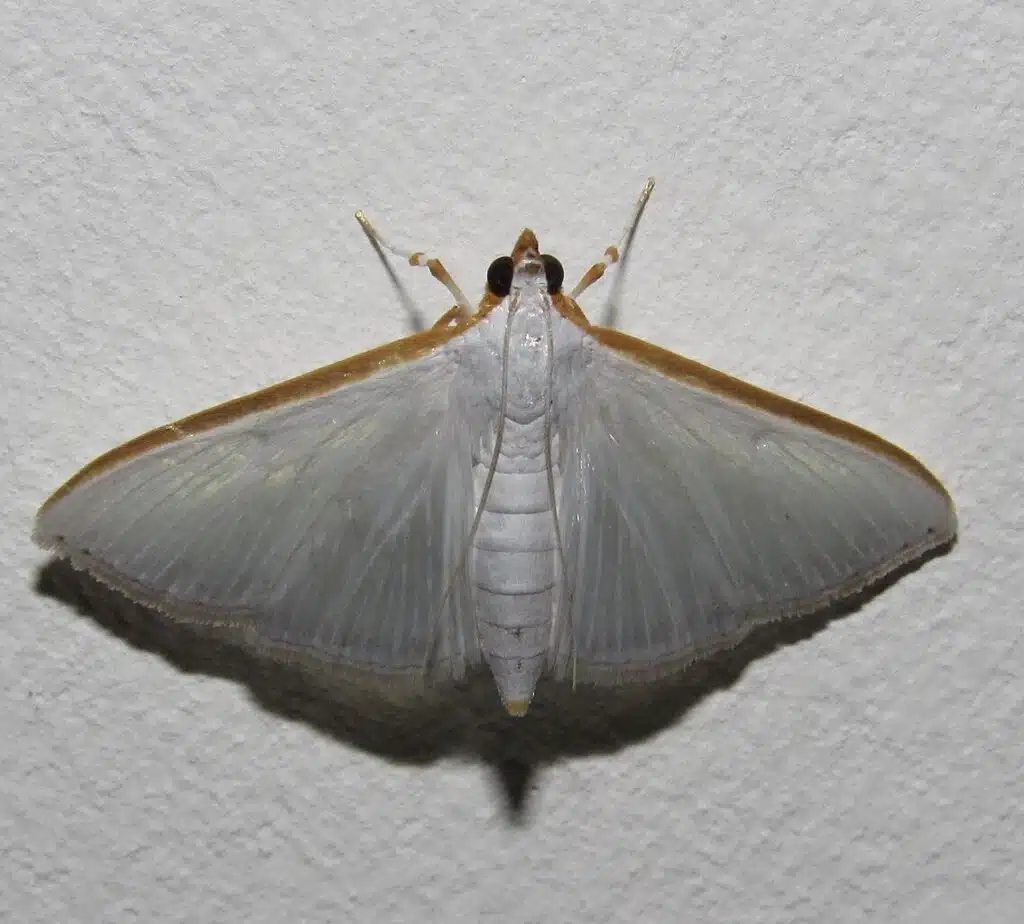
This species of white moths (Diaphania costata) are believed to have been accidentally introduced to North and Central America.
A base white color is characteristic of the Orange-shouldered Sherbet Moth.
This species has golden orange banding across the upper side of its forewings.
The species has a short wingspan that measures anywhere between 10 to 20mm.
35. Brown-tail Moth
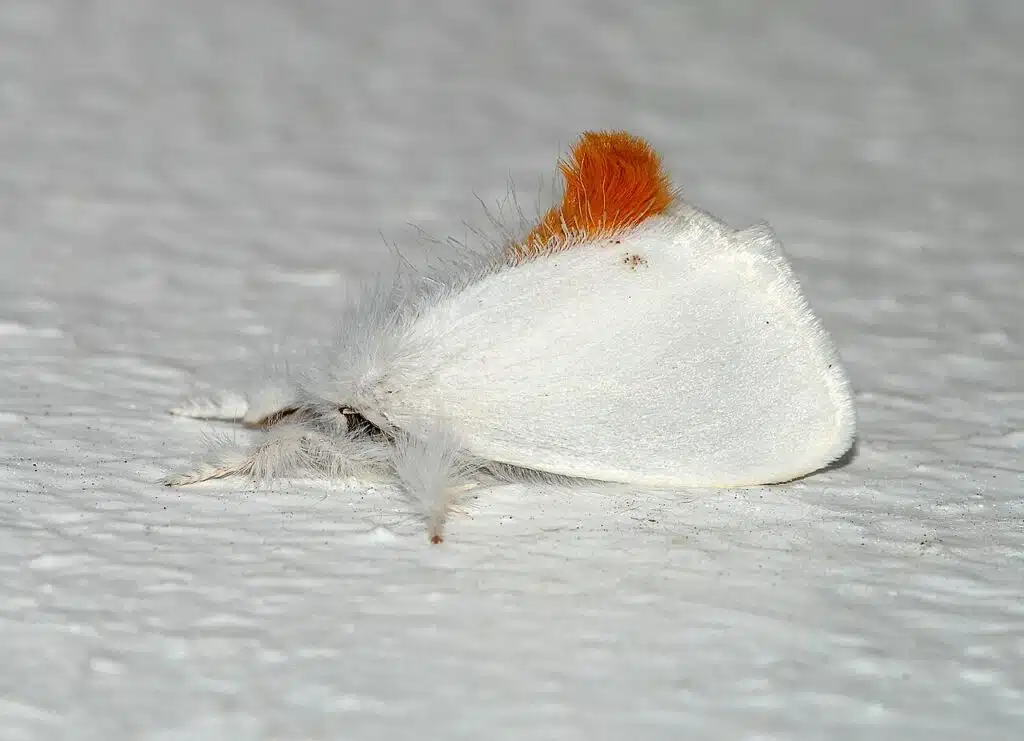
Brown-tail Moths (Euproctis Chrysorrhoea) are among the common white species introduced to North America.
Native to Europe, Brown-tail Moths are known for invading hardwood woodlands. They live on oak and poplar but also pear, raspberry, and cherry trees.
There’s a wider range of host trees, plants, and vegetation the moth is interested in.
Its larvae cause significant damage to its host.
Furthermore, the larvae of the Brown-tail Moth have urticating hairs. It causes severe skin irritation in humans.
36. Gracile Palpita Moth
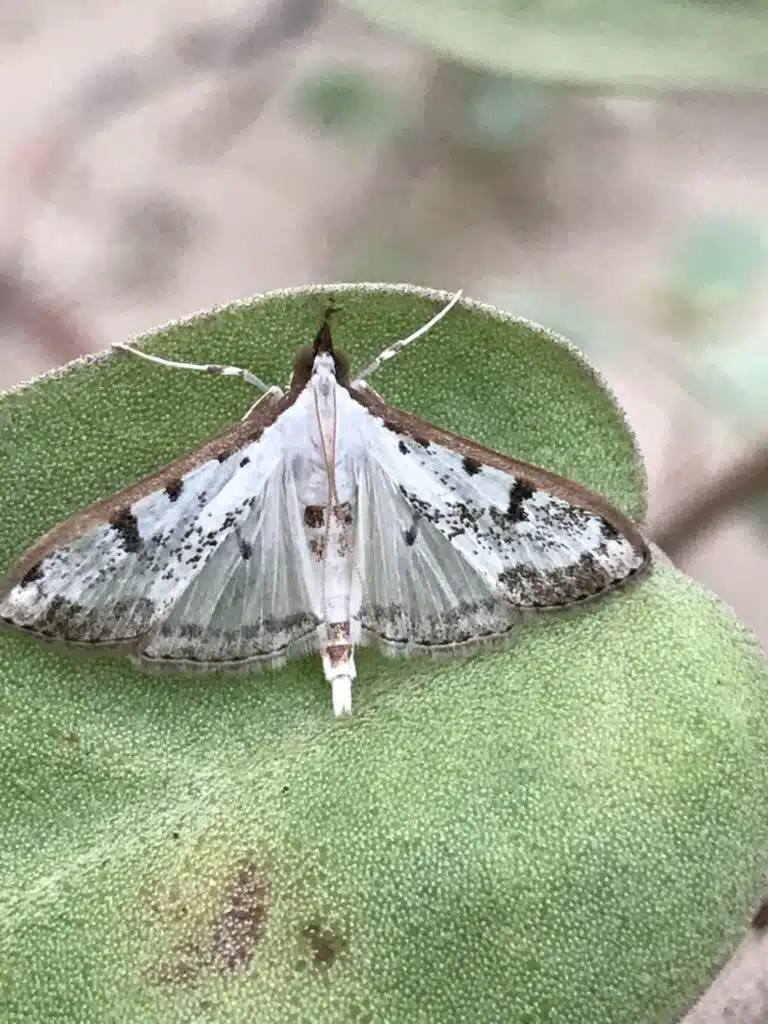
Gracile Palpita Moths (Palpita atrisquamalis) are a small species. These moths have a wingspan between 10 and 12.5mm, being one of the smallest white moths in the US.
White is not the dominant color of the Gracile Palpita Moth. It has similar coverage areas as the gray colors across the wings. The body of the moth also has gray and white colors across the body.
Brown and yellow bands are specific to the upper area of its forewings.
37. Swag-lined Wave
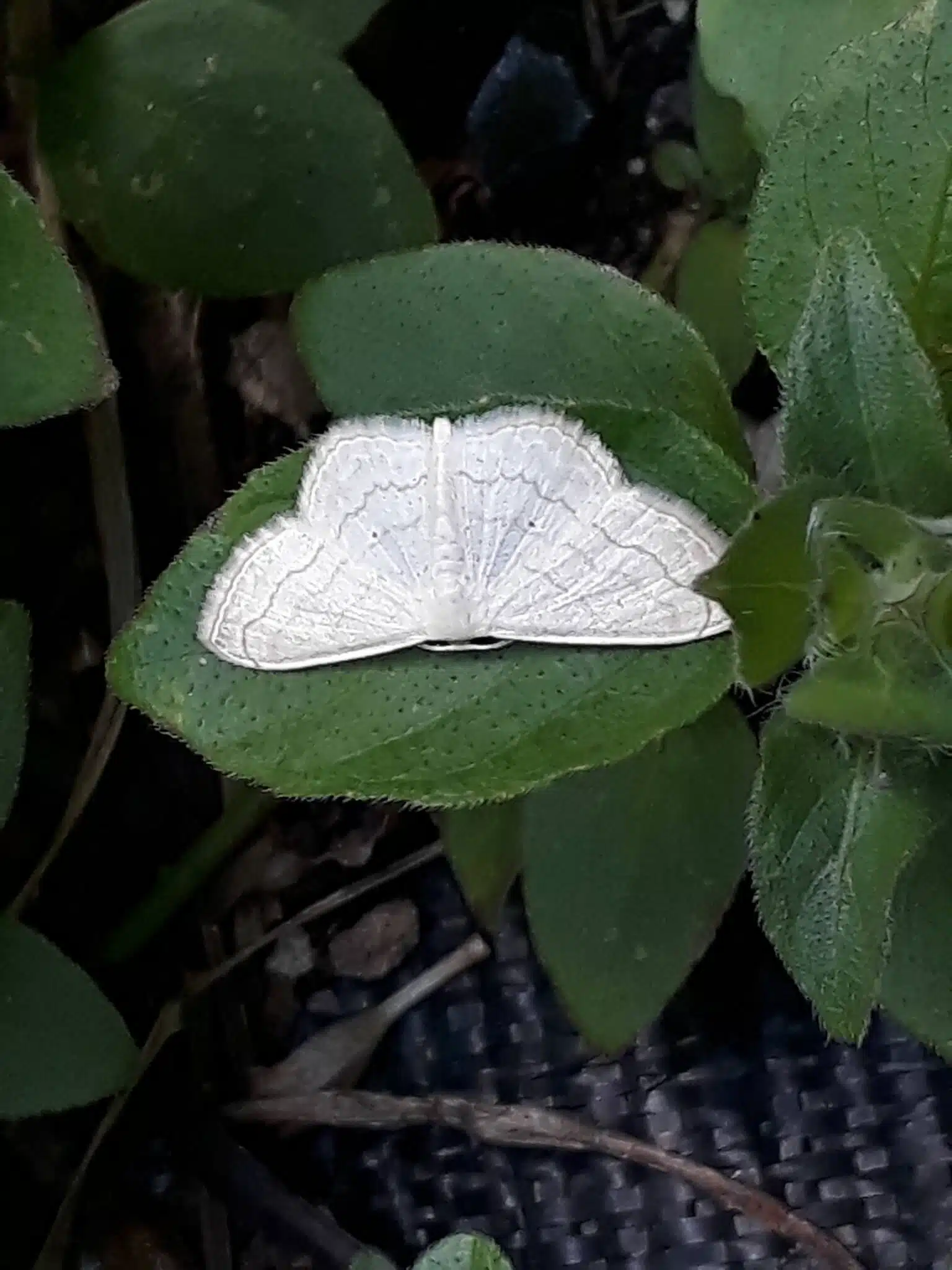
This species of white moths (Scopula umbilicata) are most commonly found in Southern US states. It has a long flight season in Florida and Texas.
Moths of this genus are also common throughout Central America.
Swag-lined Wave moths have a wingspan of up to 18mm. The species has patterned lines in the shape of waves of a cream color across its wings.
The ventral side of the wings has a base brown color. Dark brown nuances are further differentiated on the ventral wings.
A camouflaging effect is achieved by the ventral colors of the species.
38. Red-tailed Specter Moth
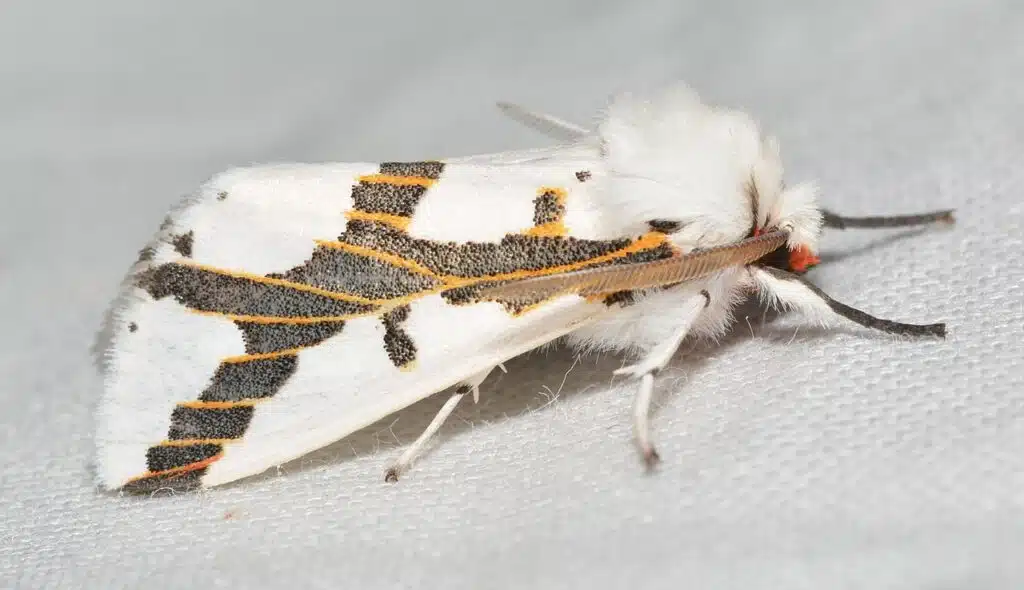
The Red-tailed Spected Moth (Euerythra phasma) is a species that gets its name from the red color of its lower body. Its upper body is white.
The forewings of the moth are white with brown marks and dots. Some moths have red marks and dots.
Pure white without marks is only specific to the hindwings of the species.
Red-tailed Specter moths have a long flight season as they are found in the Southeastern and South-Central states.
39. Yellow-headed Lichen Moth
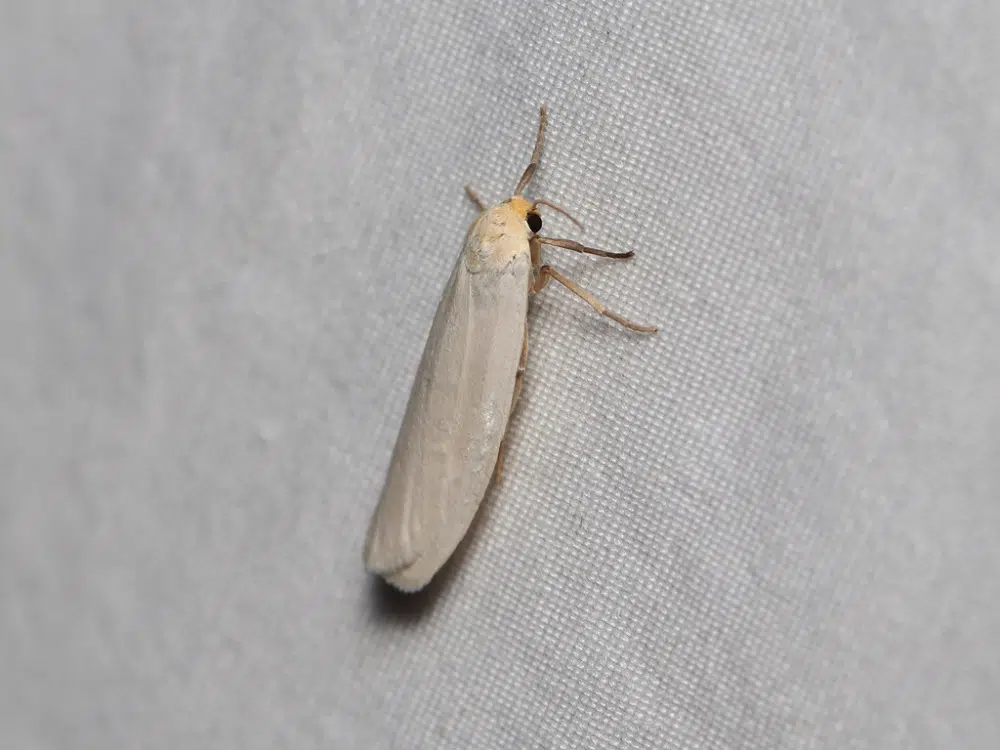
Yellow-headed Lichen Moths (Crambidia cephalica) have a widespread presence in North America up to Canada.
This species has white forewings, white hindwings, and a white body.
Yellow-headed Lichen Moths are some of the smallest white species in the US. It’s not uncommon to find this moth with a wingspan that doesn’t measure 10mm.
Lichens are the main food source of this moth. Various types of algae are the alternative food source of the Yellow-headed Lichen Moth.
40. Norape virgo
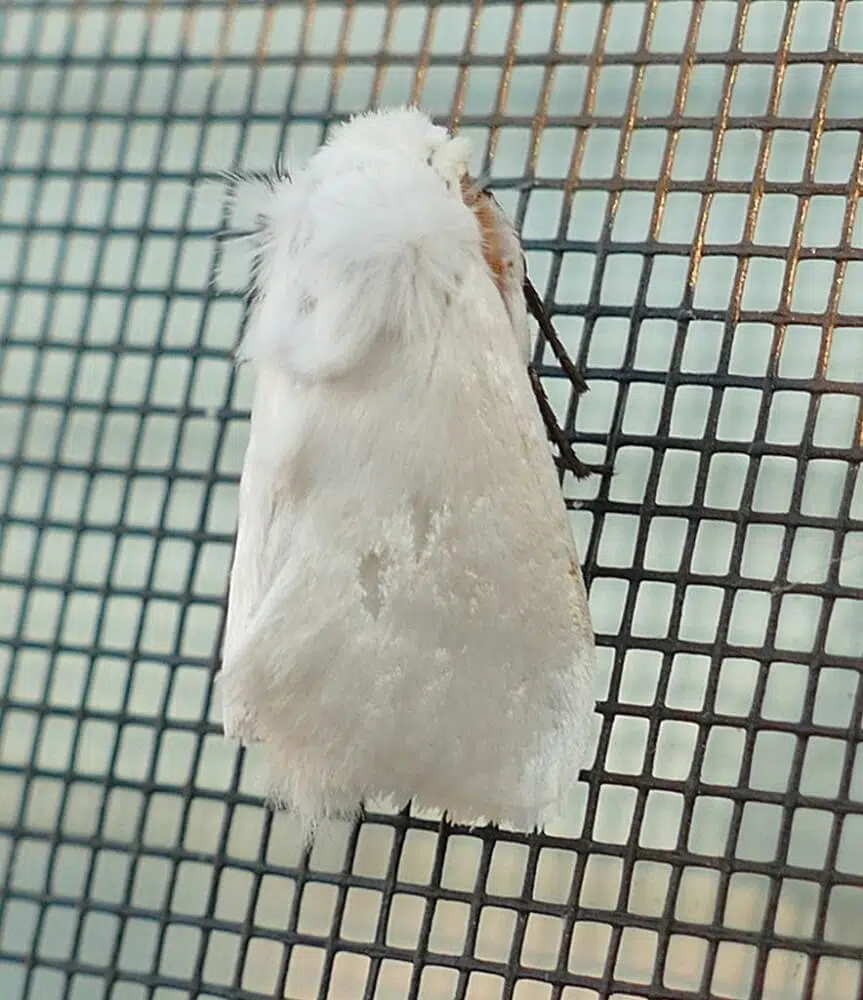
This moth species is native to tropical areas. It can be found in the extreme South of Texas and Florida in the US, in Mexico, and the Northern parts of South America.
The species has a white dominating color. Its body color is white with a few cream spots across the lower part.
Its forewings and its hindwings are all white.
The species has golden to cream patterns across the central sections of the wings that are closer to the body.
Norape virgo moths are some of the smallest white moths in the US with a scarce presence even in the states it’s reported in.
41. Satin White Palpita
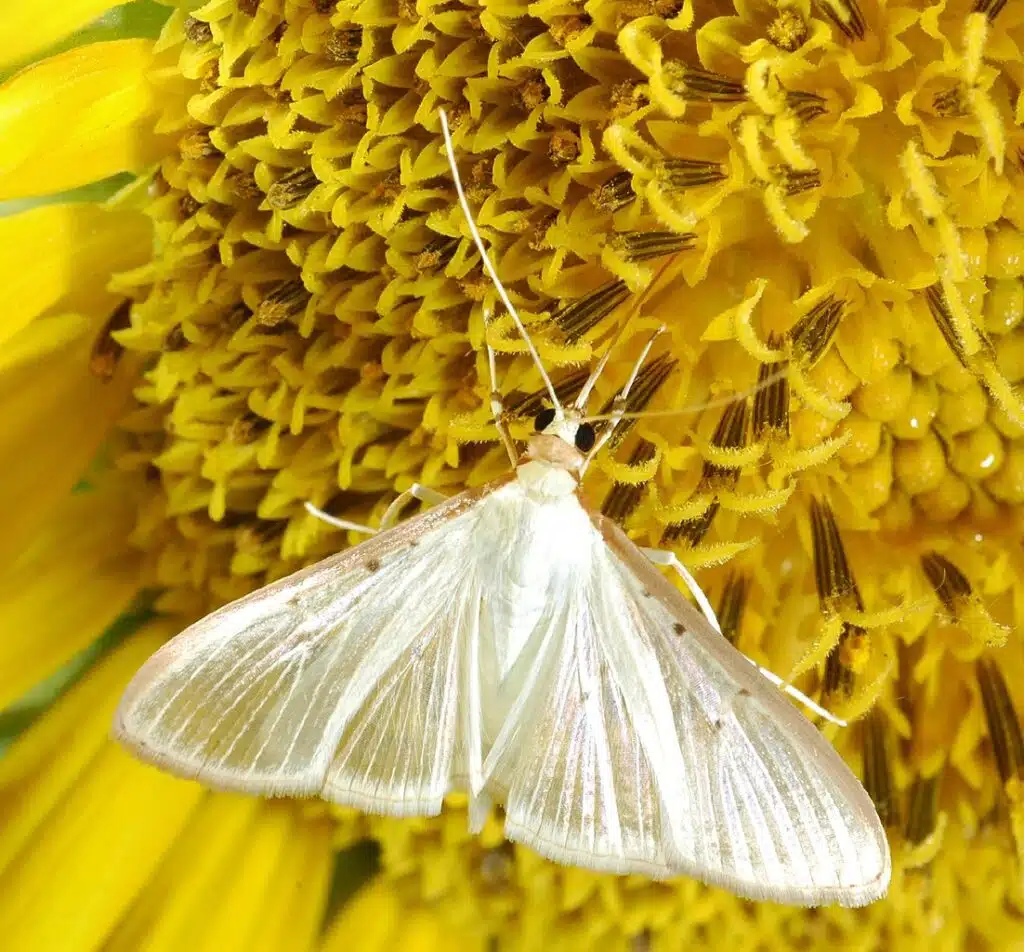
The Satin White Palpita (Palpita flegia) is a white moth species characteristic only to Southern Texas and Southern Florida.
This species has white pigmentation and partially transparent wings.
Its wings are only white on the margins with high transparency interrupted by white veins.
Moths of this family have a white body which isn’t characteristic of the caterpillar of the species which has gray, orange, and black coloring.
Satin White Papilat are the easiest to find around yellow oleander in Texas and Florida.
42. Satin Argyria Moth
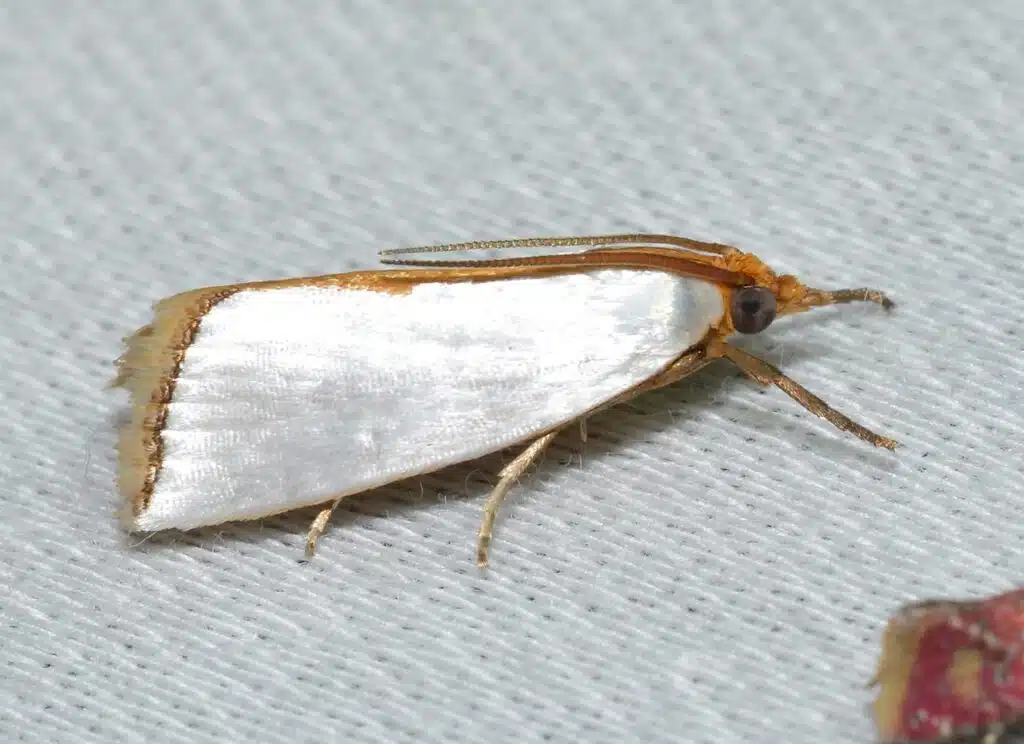
Satin Argyria Moths (Argyria nummulalis) is a native species in North America.
Satin Argyria Moths are the most common in Eastern US states such as Maryland and North Carolina. Its presence is also common in Florida.
This species is one of the smaller white moths across the US. Its wingspan measures an average of 10mm.
Its forewings are white without any large colored spots apart from the orange-red margins.
The hindwings of the species are mostly orange or orange-brown.
The white nuance of the species has a slight satin tint which inspires its name. This species of Argyria moths don’t have a bright white color and it resembles the Straight-lined Argyria Moth in its nuance.
Further Reading: